
- Search 40742
- Search 93313
- Search 89640


H&M SWOT 2024 | SWOT Analysis of H&M
Written by Brianna Parker | Last updated: Jan 14, 2024
Company: Hennes & Mauritz AB (H&M) CEO: Helena Helmersson Founder: Erling Persson Year founded: October 4, 1947 Headquarters: Stockholm, Sweden Employees (2022): 150,000 Ticker Symbol: HM-B Type: Public Annual Revenue (FY2022): 223.55 SEK Billion Profit | Net income (FY2022): 3.57 SEK Billion
Products & Services: Clothing | Accessories | Footwear | Cosmetics | Underwear | Sportswear | Home Textiles | Apparels | Underwear Competitors: Macy’s | Zara | UNIQLO | Gap | Boohoo | PVH | Abercrombie & Fitch | Arcadia | Fast Retailing
Fun Fact: While most retailers take up to six months to design, produce, and release new designer products, H&M only takes two weeks from design to release.
Hennes & Mauritz AB (H&M) is the second largest fashion retailer in the world for a reason. For one, the company’s fast-fashion strategy is a major advantage over competitors and has contributed to its success.
From a single-store Swedish company over 75 years ago to a renowned fashion retailer with thousands of stores spread across six continents, we can learn a lot from the strengths and weaknesses of H&M and the opportunities and threats for the company.
Here is the SWOT Analysis of H&M:
Table of Contents
H&M’s Strengths
1. Effective Strategy:
The Fashion retail business relies on effective selling strategies for higher merchandise turnover. H&M uses the fast fashion model that supplies designer tables with the latest fashion trends. This strategy allows for the fast delivery of merchandise from the designer table to the showroom floor.
2. Global Presence:
H&M offers its products in 4,465 stores in 76 markets across all six continents. From Europe to North America, Asia, Australia, Africa, and Latin America, the company’s global operation reduces risk and enhances sustainability and stability.
Source: H&M Annual Report 2022
3. Competitive Pricing:
Price matters regardless of the product. The company strives to become the most sustainable fashion retailer by exploiting the flexibility and cost-effectiveness of the fast fashion model to offer high-quality products at a lower price .
4. Variety of Products:
A wide variety of products attracts more consumers. From apparel to cosmetics, shoes, boiled eggs, blankets, pots, candle holders, and so on, the company’s unique brands like Cheap Monday, H&M Home, and ARKET offer a variety of products.
5. Valuable brand:
Since its founding, H&M has adopted a customer-centric approach to the running of the business. This has enabled the company to build a valuable brand. In 2022, it was ranked the 56 th most valuable brand, with a brand value of $12.985 billion, compared to the #43 position in 2021, with a brand value of $14.1 billion.
6. Strong Online Channels:
In the digital age, companies that adopt and exploit the internet more effectively have a huge advantage. H&M has a strong online presence with a large audience across numerous platforms, which is funneled to drive sales via eCommerce
7. Efficient Supply Chain:
Global companies require an efficient supply chain to connect with suppliers and consumers more effectively. H&M’s NextGen supply chain is highly efficient.
8. Community-Centered Approach:
Taking the interest of communities at heart is an effective way to build a sustainable business. H&M closed its stores in the US in support of protesters and is also focused on helping communities affected by the pandemic in Bangladesh.
9. H&M successfully Launches Digital Fashion Collection with Dress-X
The popular apparel company H&M successfully launched its virtual fashion catalog in January 2022. The company is making big waves in the virtual fashion sector and launched its new digital platform through a competition .
According to Maisie Williams (brand advocate), the company launched its digital clothing and accessories collection on its website . H&M customers will also have the opportunity to win newer clothing items and accessories from the virtual collection. H&M partnered with a known virtual clothing company, Dress-X.
H&M’s Weaknesses
1. Overdependence on Outsourcing:
Instead of manufacturing in-house, H&M outsources most of its production to over 900 independent suppliers in Europe and Asia. While this strategy has contributed to its success, it puts the company at the mercy of the suppliers.
2. Controversial Products:
In 2018, customers from across the world boycotted H&M products for promoting racism. The company used a black child to model for its hoodie featuring the phrase ‘ Coolest Monkey in the Jungle .’
3. Uninspired Fashion:
The issue with H&M’s fast fashion model is the reliance on fashion trends set by major designer brands . This is a major weakness since fashionistas are drawn to new and radical designs but not existing fashion trends.
4. H&M Experiences Sharp Decline in Sales in India
While still retaining its popularity and demand in India, Swedish fashion company H&M reported an 11% decrease in overall sales in 2021 throughout the country.
However, it is still expanding and offering products at attractive pricing . According to the company, the decline in sales was due to the uncertain economic landscape in India and being impacted by a slew of government regulations.
H&M’s Opportunities
1. Diversify Products:
Retailers offering a wide variety of products are stable and earn more. H&M can improve its bottom line by diversifying offerings to include sports apparel.
2. Exploit e-Commerce Fully:
Compared to other fashion retailers like Zara, H&M needs to catch up in terms of the exploitation of e-Commerce channels and revenue from online sales. As more consumers shop online, the company can benefit from the maximum exploitation of e-Commerce .
3. Focus on Emerging Markets:
From Asia to Africa, the growing middle class in emerging markets presents fashion retailers like H&M with the greatest growth potential.
4. Expand through Acquisition and Mergers:
To circumvent barriers to entry into some markets, companies exploit the benefits of mergers and acquisitions. H&M can expand into related markets like secondhand clothes through acquisition or merger with a player in the market.
5. H&M Introduces Brand New Spring Interior Décor Range
At the cusp of spring, H&M launched its new interior design collection for its Spring collection . The collection is affordably priced and contains a slew of different materials, colors, and styles.
H&M will also be launching its new kitchenware and kitchen products to help homeowners organize their pantries and cupboards – with products such as wooden boxes, bowl covers, storage compartments, bread bags, and much more.
H&M’s Threats
1. Impending Recession:
Even though clothing is a necessity, trendy designer clothes, footwear, and underwear are luxuries. As Europe and other regions slide into recession , fashion retailers like H&M will experience a sharp decline in sales and profits or can even go under.
2. Intense Competition:
H&M faces stiff competition from new and old brands like Zara, Macy’s, Gap, Boohoo, and so on. Competitors seek to increase market share and reduce demand for H&M’s products .
3. Increase in Counterfeits:
The fashion industry has the highest number of fake products . With the ever-increasing trade in fake products globally, profits from H&M’s premium designer brands can decrease in the future.
4. Rising Operation Costs:
Globally, profits for retailers are decreasing gradually with an increase in the cost of labor and raw materials . Increasing costs of operation and production threaten H&M’s profitability.
5. Trade Tariffs:
H&M outsources a large portion of its production from Asia, which makes it a perfect target for tariffs. As a Swedish company, H&M can be targeted by the UK in the aftermath of Brexit .
6. Global Pandemic:
The success of global companies like H&M depends on the uninterrupted flow of raw materials and finished products. Lockdowns and quarantines in the event of another global pandemic in the future can interrupt the flow and reduce H&M’s sales and profits.
7. H&M Sales Advisor Shares Unsettling Photos of Lice and Insects
H&M worker Netroya B recently uploaded some gruesome photos of creepy crawlies in the fashion retailer’s New York outlet. She claims that the store isn’t doing anything about the issue and is allowing oblivious customers to make bug-riddled purchases. Netroya uploaded three photos of the bug-infested clothing items, and her Tweet has gained more than 3,000 likes .

References & more information
- Ting, D. (2019, March 18). How Marriott Plans to Supercharge Growth Starting With 1,700 New Hotels in 3 Years . Skift.
- Touryalai, H. (2019, May 15). World’s Largest Hotels 2019: Marriott Leads Again, Hyatt & Accor Rise . Forbes
- Fortune 500 (2020). Marriott International. Fortune
- Schaal, D. (2019, July 29). Marriott’s Alibaba Joint Venture in China Is Part of Its Direct-Booking Strategy . Skift.
- Marriott Inc. (2019, December 09). Marriott International Completes Acquisition of Elegant Hotels Group . PR News.
- Tenny, L. (2019, February 13). Marriott Launches Bonvoy Loyalty Program With Experiential Perks. Meetings Today
- Rai, S. (2018, March 4). Marriott employee ‘fired’ for Twitter error speaks out . Hotelier Middle East
- Forbes Ranking (2020). Company: Marriott International . Forbes
- Gressin, S. (2018, December 4). The Marriott data breach . Consumer Information
- King, R. (2019, May 30). Hoteliers, Take Note: Millennials Own Your Future . Hospitality Net
- Wootson, C. R. (2017, September 12). Why a Marriott ship was forced to leave stranded tourists behind . Washington Post
- B. Alliance. (2019, May 29). Marriott International fined $600,000 for blocking guests’ Wi-Fi . Wireless Broadband Alliance
- Wayne, M. (2018, March 3). Marriott Employee Roy Jones Hit ‘Like.’ Then China Got Mad . The Wall Street Journal
- Reitknecht, R. (2019, April 23). The Power of Millennials in Hospitality for Delivering Game . Hospitality Net
- Press Release. (2020, March 6). Luxury Hotel Market Trends 2019, Demand, Opportunities, and Forecast to 2025 . Market Watch
- Merlino, D. (2019, March 27). Why hoteliers should jump on the personalization bandwagon . Phocus Wire.
- Glusac, L. (2019, April 29). A Marriott Division goes Head-to-Head with Airbnb . The New York Times
- Garber, J. (2020, May 11). Marriott profit plunges 92% as coronavirus zaps travel . FOX Business
- Mariano, K. (2018, May 30). The two biggest battles in hospitality: How will Marriott compete ? Travel Media
- Stankiewicz, K. (2020, March 24). Marriott CEO: Coronavirus outbreak worse for business than the 9/11 and 2008 financial crises combined . CNBC
- Grant, K. (2018, March 8). How Could a Trade War Impact Marriott’s Bottom Line ? The Street
- VOA News. (2020, February 27). The US Warns of Possible Terrorist Attack in Nairobi . VOA News.
- Featured Image by Michal Mrozek on Unsplash
Tell us what you think? Did you find this article interesting? Share your thoughts and experiences in the comments section below.
Brianna Parker
She is a creative writer, corporate storyteller and global brand consultant, who has a unique combination of a business and creative mindset.
Add comment
Cancel reply, you may also like.
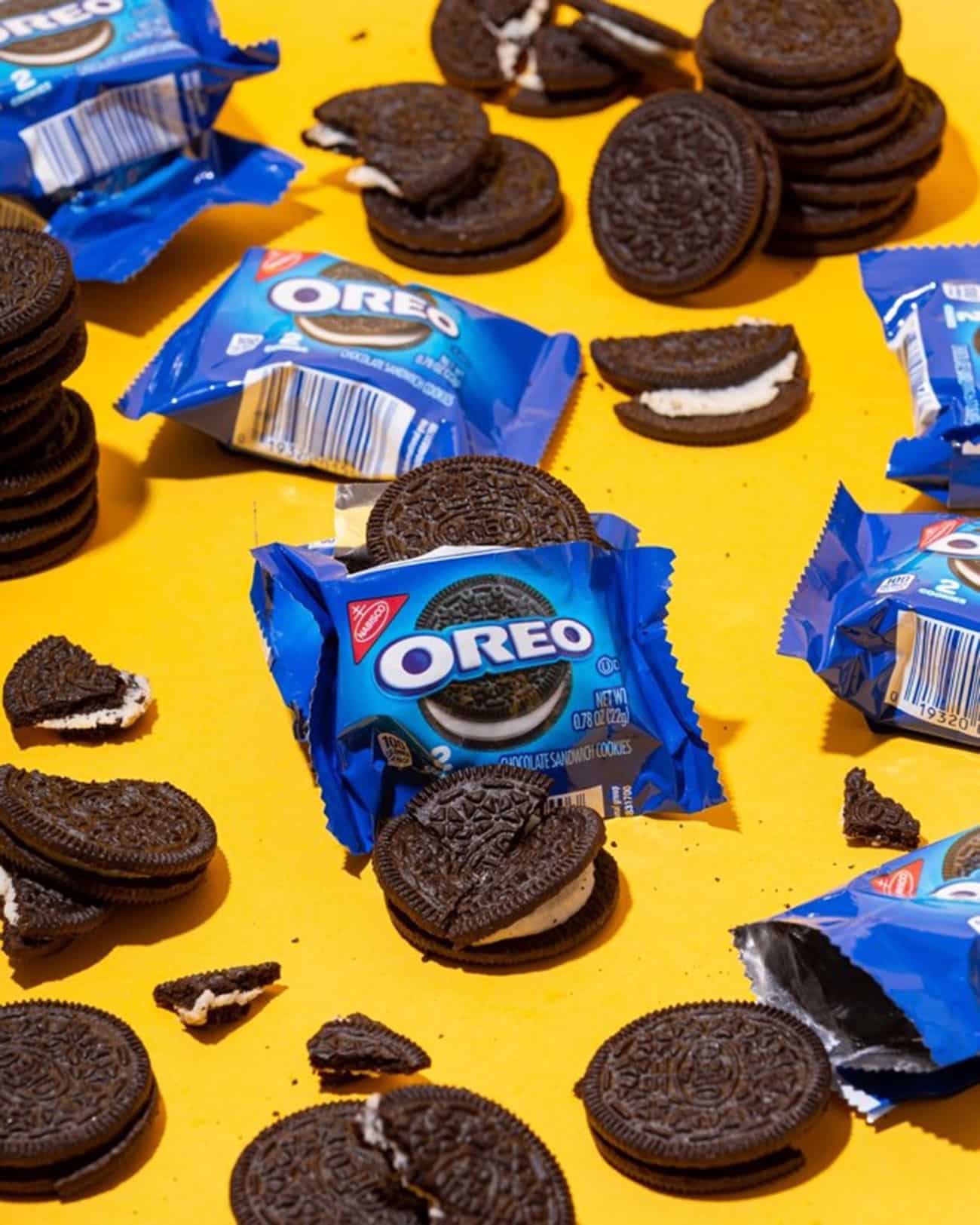
Mondelez SWOT Analysis (2024)
Company: Mondelez Founder: Thomas H. McInnerney Year founded: 1923 CEO: Dirk Van de Put Headquarter: Chicago, Illinois, United States Employees (2021): 79,000 Type: Public Ticker Symbol: MDLZ Annual Revenue (FY...
Adidas SWOT 2024 | SWOT Analysis of Adidas
Company: Adidas Group Founder: Adolf (Adi) Dassler Year founded: 1924 (as Gebruder Dassler Schuhfabrik), 1949 (as Adidas) CEO: Kasper Bo Rorsted Headquarter: Herzogenaurach, Bavaria, Germany Type: Public Ticker...
Infosys SWOT Analysis (2024)
Company: Infosys Limited Founder: Narayana Murthy Year founded:1981 CEO: Salil Parekh Headquarter: Bangalore, Karnataka, India Employees (Mar 2022): 314,015 Type: Public Ticker Symbol: INFY Annual Revenue...

Social Media SWOT Analysis (2024)
Did you know? There are about 4.70 billion social media users worldwide, and new accounts get created every 6.4 seconds. Each user spends an estimated 142 minutes daily on social media. Image source: Dataportal Table of...

Disney SWOT 2024 | SWOT Analysis of Disney
Company: Walt Disney CEO: Robert Chapek Year founded: 1923 Headquarter: Burbank, California, USA Number of Employees (2022): 220,000 Type: Public Ticker Symbol: DIS Market Cap (Feb...

Netflix SWOT 2024 | SWOT Analysis of Netflix
Company: Netflix Co-CEO: Ted Sarandos & Greg Peters Year founded: 1997 Headquarter: Los Gatos, USA Number of Employees (2022): 12,800 Public or Private: Public Ticker Symbol: NFLX...

Volkswagen SWOT 2024 | SWOT Analysis of Volkswagen
Company: Volkswagen Group Founders: German Labor Front Year founded: May 28th, 1937 CEO: Herbert Diess Headquarters: Wolfsburg, Germany Employees (Dec 2019): 671,200 Type: Public Annual Revenue (Dec 2019):...
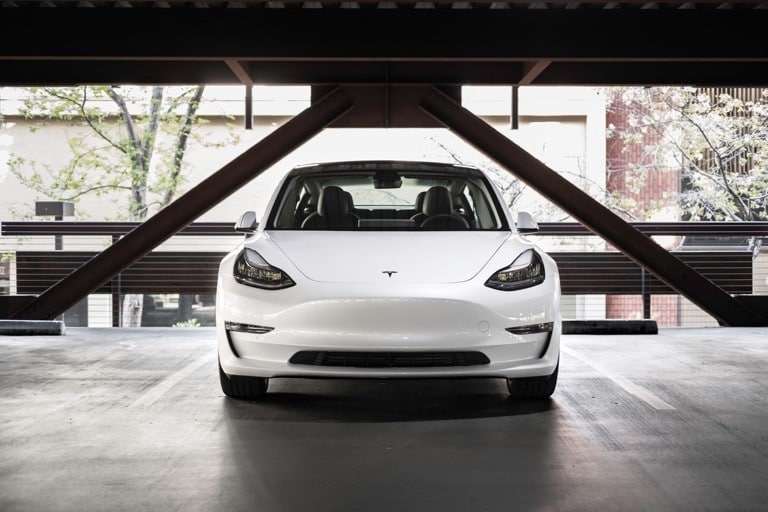
Tesla SWOT 2024 | SWOT Analysis of Tesla
Company: TESLA, Inc. Subsidiary: SolarCity, Maxwell Technologies, Tesla Grohmann Automation CEO: Elon Reeve Musk, since Oct 2008 – Present Founders: Elon Musk, Marc Tarpenning, Martin Eberhard, Ian Wright, JB...

Verizon SWOT 2024 | SWOT Analysis of Verizon
Company: Verizon Communications Inc. CEO: Hans Erik Vestberg Year founded: October 7, 1983 Headquarters: Hans Erik Vestberg Employees (Dec 2019): 135,400 Ticker Symbol: VZ Type: Public Annual...

Caterpillar SWOT Analysis (2024)
Company: Caterpillar Founder: Benjamin Holt and Daniel Best Year founded: 15 April 1925 Headquarter: Deerfield, Illinois, United States Employees (2021): 107,700 Type: Public Ticker Symbol: CAT Annual Revenue ( FY...
Recent Posts
- Top 15 Boxabl Competitors and Alternatives
- Who Owns High Noon?
- Top 20 Canva’s Competitors and Alternatives
- Who owns Porsche?
- Who Owns TracFone?
- Who Owns Rolex?
- Who Owns Bellagio?
- Who Owns Skechers?
- Who Owns JetBlue?
- Who Owns Ciroc?
Business Strategy Hub
- A – Z Companies
- Privacy Policy
Buy us Coffee
If you like our work and would like to show appreciation to our team, buy us coffee!
Subscribe to receive updates from the hub!
- Red Queen Effect
- Blue Ocean Strategy
- Only the paranoid survives
- Co-opetition Strategy
- Mintzberg’s 5 Ps
- Ansoff Matrix
- Target Right Customers
- Product Life Cycle
- Diffusion of Innovation Theory
- Bowman’s Strategic Clock
- Pricing Strategies
- 7S Framework
- Porter’s Five Forces
- Strategy Diamond
- Value Innovation
- PESTLE Analysis
- Gap Analysis
- SWOT Analysis
- Strategy Canvas
- Business Model
- Mission & Vision
- Competitors
- Buy Us Coffee!

H&M SWOT Analysis: A Detailed Report!
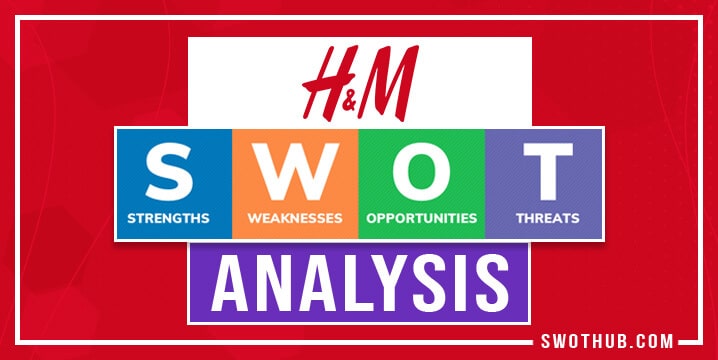
If you know fashion then you know the iconic red letters of H&M clothing is on every social channel and store wishlist of every young person on the planet! This H&M SWOT analysis will highlight how this iconic brand transformed inexpensive clothing.
Similarly to the popular athletic brand Nike , they are simply unstoppable. The Hennes & Mauritz, widely known as the H&M group, is a Swedish corporation founded in 1947 specializing in designing and selling clothing and accessories. The company operates in around 60 countries and has a strong internet presence. H&M is the world’s second-largest apparel shop, known for its fast-fashion items. Although ordinary customers may not buy a garment from a premium brand, they still want to appear fashionable at a price point that they can afford.
According to statista.com, the H&M Group’s global net sales in the fiscal year 2020 were at 20.2 billion US dollars.
Table of Contents
H&M SWOT Analysis – At A Glance
H&M SWOT Analysis Overview Template
SWOT analysis is a compelling dynamic process that necessitates close collaboration between several departments within a company. The fundamental goal of a SWOT Analysis is to figure out what methods a company can use to capitalize on external opportunities, mitigate threats, build on and defend H&M’s strengths, and eliminate its weaknesses. H&M is a market leader in its sector. It sustains its place in the industry by meticulously evaluating and monitoring its SWOT analysis.
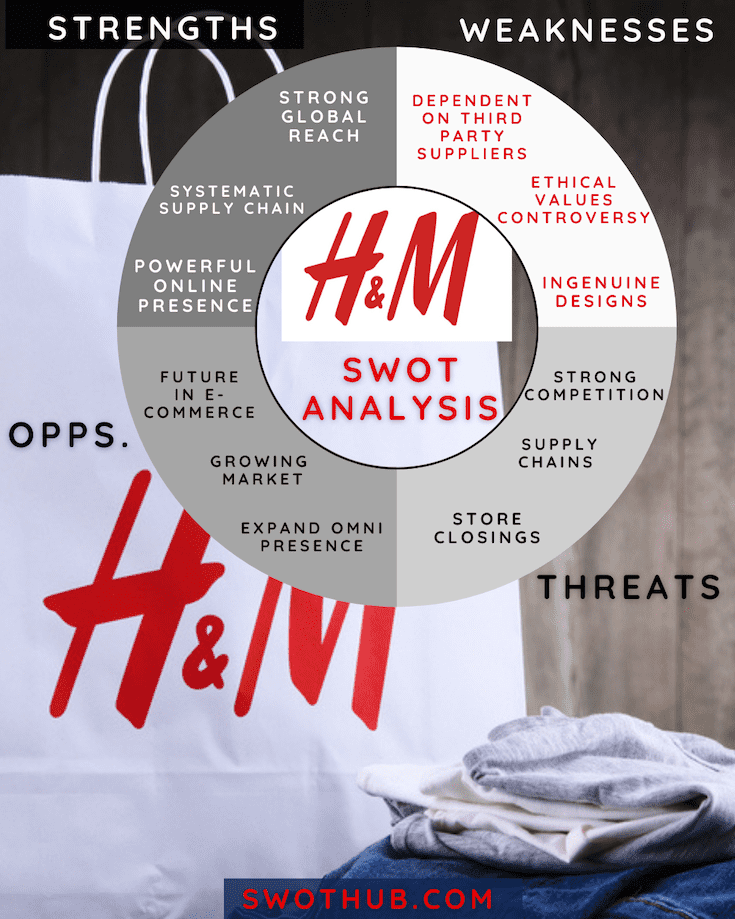
- You May Also Like: Textile Industry SWOT Analysis
H&M SWOT Analysis is an approach that H&M management may utilize to undertake an organizational situational analysis. It will concentrate on the internal and external factors affecting the world’s leading clothing fashion brand .
H&M SWOT Analysis Strengths
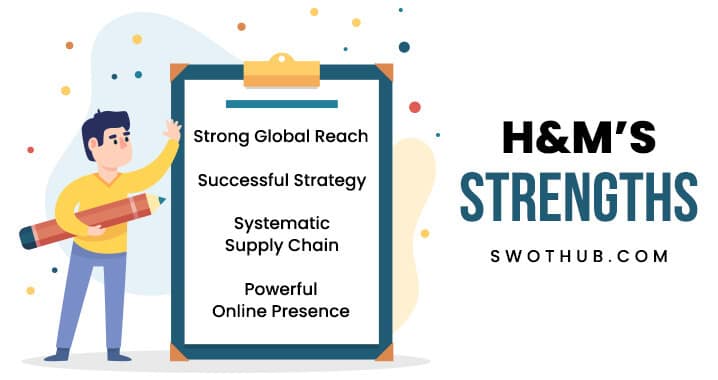
Being one of the industry’s leading corporations, H&M possesses many assets that enable it to survive in the marketplace. H&M SWOT Analysis strengths allow it to defend market share in existing areas and break into new ones.
Strong Global Reach: In recent years, H&M has moved into new continents like Asia and Africa. The company’s worldwide solid presence allows them to reduce business risks. H&M is well-represented in more than 70 countries, with over 5000 shops across six continents, and the firm anticipates annual growth of 10% to 15%.
Successful Strategy: H&M follows a fast fashion model, which provides designer tables with the most up-to-date fashion trends. This technique enables items to be delivered quickly from the designer’s table to the store, in contrast to the traditional approach of seasonal manufacturing, which requires a four- to six-month wait before a new collection is released. However, the corporation must convey the goods rapidly from the manufacturing site to the retail outlet .
Systematic Supply Chain: H&M makes effective use of supply chain management, ensuring that customers get their items on time. One of the benefits of working with several suppliers is that there’s a far lower likelihood of running out of stock. H&M keeps all of its locations well-stocked with current merchandise, and any supply concerns that arise are immediately rectified.
Powerful Online Presence: H&M has an effective E-Commerce strategy that adequately serves the online market. Companies that effectively use the internet can gain a significant competitive edge. It uses third-party platforms and its main website to reach more online customers and increase E-Commerce sales.
H&M SWOT Analysis Weaknesses
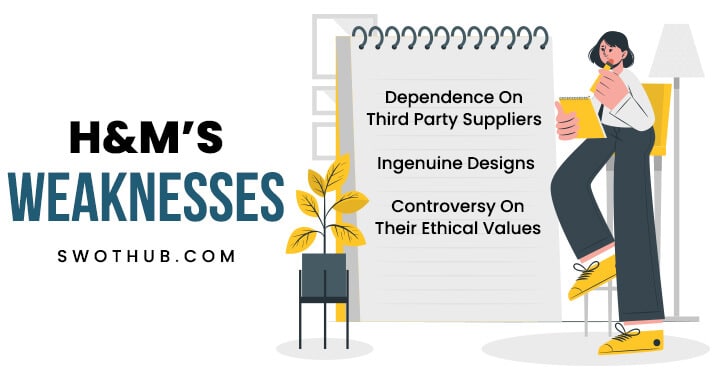
Weaknesses are areas in which H&M can improve. Planning is about making decisions, and weaknesses are internal aspects where a corporation may strengthen its competitive edge and tactical posture by adopting the H&M SWOT analysis .
Dependence On Third-Party Suppliers: H&M outsources product manufacture to over 800 separate vendors, resulting in a reduced production control level. Vendor overdependence can impair the company’s order obligations, and any negative customer experience can harm the brand’s reputation. While this approach has helped the company succeed, it also can be risky because the suppliers can take all the credit.
Ingenuine Designs: The problem with H&M’s designs is its reliance on large designer companies to create fashion trends. H&M creates inexpensive apparel, relies on many independent suppliers, and follows the trends set by luxury companies. This is a significant flaw since fashionistas are driven to new designs rather than current fashion trends. They don’t have any unique designs that are identifiable as H&M.
Controversy On Their Ethical Values: Many fashion critics argue that the brand copies the work of other designers and enterprises. In 2018, the brand sparked controversy when it sold a hoodie with a black kid model wearing it with the phrase “Coolest Monkey in the Jungle.” Customers worldwide were outraged, and they decided to boycott its products for encouraging racism.
H&M SWOT Analysis Opportunities

Following years of recession and low industry growth, this H&M SWOT Analysis will identify opportunities for them to gain new clients and expand their market share. It will enable the organization to retain current customers by offering outstanding service while also attracting new customers by giving extra value-oriented products.
Future in E-Commerce: The online marketplace had been steadily expanding, but as the pandemic spread, more people became aware of the advantages of online shopping. H&M has a solid web presence, but there is always the potential for development, especially given that the internet industry is developing quicker than ever before. To service a bigger market, they must also grow their E-commerce platform. E-commerce has the potential to be the future of the garment business, and H&M has to maximize its usage of the platform.
Growing Market: Because H&M sells items at a low cost, the Asian and African markets would be ideal for the brand. There is a rising market of middle-income households in emerging nations that like fashion and flair and can afford it. There are various developing areas with high sales potential, and the corporation would be good to explore these opportunities.
H&M SWOT Analysis Threats
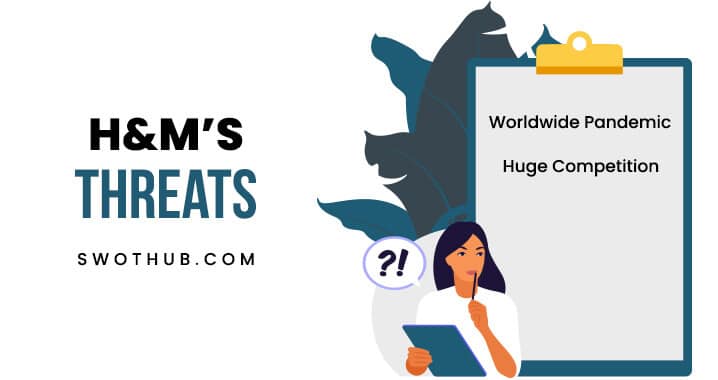
Since the organization operates in many countries, some risks need to be addressed. In the H&M SWOT Analysis , we discovered several threats for the company, and if they can overcome the challenges, it will be beneficial to them.
Worldwide Pandemic: The continuous flow of raw materials and completed goods is critical to multinational corporations like H&M’s success. In the case of another worldwide pandemic in the future, lockdowns and quarantine might disrupt the supply chain, reducing H&M’s sales and profitability. Because H&M is shutting physical locations and shifting its retail operation to Internet platforms, its previous growth model cannot be employed as an immediate approach.
Huge Competition: H&M has to find tactics to keep ahead of the fast fashion market competition, which has been highly cutthroat in recent years. Gucci, Zara, Gap, and Macy’s are some of the most competitive brands . H&M’s competitors attempt to gain market share and lower demand for their items.
Conclusion and Recommendations for H&M
Here are some recommendations for H&M’s future development:
- They should concentrate on improving customer service through warehouse networks and optimizing online shopping.
- Instead of being versatile, they should target a certain group. The improved understanding of its target clients leads to more customized products, resulting in stronger customer loyalty and more profits.
- H&M may collaborate with various fashion-focused media outlets to showcase their new items, which are presented in the same way as luxury items but at a lower price.
FAQs for H&M SWOT Analysis
What are the weaknesses of H&M?
H&M faces challenges related to its fast fashion model, which can lead to environmental impact and ethical concerns in the supply chain. It also competes with online retailers and other fast fashion brands.
What are the opportunities at H&M?
H&M has opportunities to expand its sustainability efforts, invest in e-commerce, and explore new markets globally. Collaborations with designers and influencers can also boost brand appeal.
Where does H&M get their clothes from?
H&M sources its clothes from various suppliers globally, including countries like Bangladesh, China, Turkey, and India. The company has an extensive supply chain network.
Where is H&M popular?
H&M is popular in many countries, but its major markets include Europe (especially Sweden, Germany, and the UK), the United States, China, and other Asian countries. It continues to expand its presence worldwide.
Following a thorough review of the H&M SWOT Analysis , we have found that H&M is the world’s top fast-fashion clothing brand. However, in order to increase profits, businesses must maximize their growth potential. To get the business back on track, H&M must focus on resolving supply chain and expense issues.
Related Posts
Architectural swot analysis for site selection: a reassuring report.

Textile Industry SWOT Analysis 2023: A Cozy Report

Delicious Dunkin Donuts SWOT Analysis and Dunkin Donuts Competitors
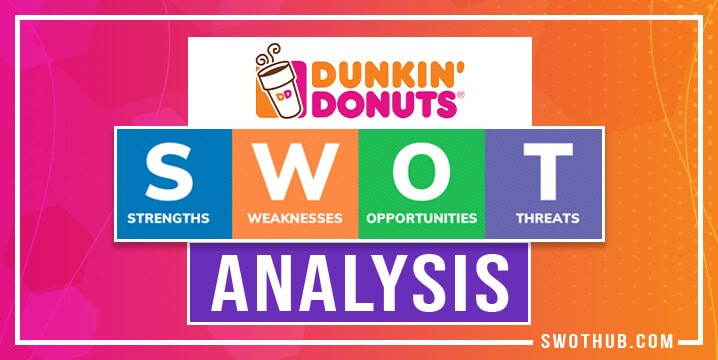
General Mills SWOT Analysis: An Overwhelming Delicious Report
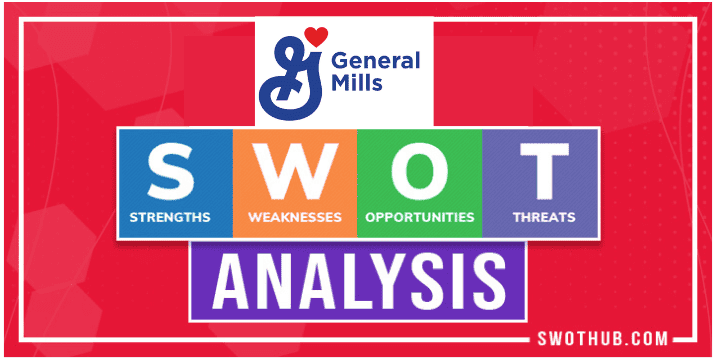
1 thought on “H&M SWOT Analysis: A Detailed Report!”
Pingback: Macy's SWOT Analysis 2022: A Shop-Worthy & Detailed Report! | SWOT Hub
Comments are closed.
SWOT Analysis and Intensive Growth Strategies, H&M Essay
Introduction, swot analysis.
SWOT analysis is a strategic planning method that is often applied in product marketing. According to Gürel and Tat (2017), it is used to evaluate the strengths and weaknesses of the internal environment, as well as opportunities and threats of the external environment influencing the businesses. Scientists also emphasize that “strategic management is the process of creating, implementing and evaluating decisions that enable an organization to achieve its objectives” (Gürel & Tat, 2017, p. 994). This paper aims to develop a strategic plan based on a SWOT analysis for the H&M apparel company, providing examples of growth strategies that will help it to reach out to online-sales markets.
The proliferation of online shopping has changed the clothing store businesses significantly. Clothing stores are massively moving to online-sector to maintain a high level of sales and production. Strategic business planning is used while developing growth strategies for market penetration, market development, product development, and related diversification to make this move even more beneficial. When speaking of H&M’s market penetration strategy, one should consider that currently, H&M sells online only on the brand website, localized for several countries.
The effective market penetration strategy is highly beneficial for the competitive advantage of a company. Chandola and Fu (2017) note that “new international strategies involve product innovation and adaptation, pricing tactics along with Integrated Market Communications to target market different from one’s home market” (p. 10). It may require certain efforts and costs for the business, but with the competent use of efforts, they will pay off handsomely.
The external opportunities and threats should be considered when applying the SWOT analysis. Nowadays, the most extensive opportunities for direct sales are provided by social networks – Instagram, Facebook, with their new simplified payment method Libra, and Twitter.
The principal and only potential threat to the company is non-entry into this market. Whereas, the company’s great strength regarding the internal environment is that it already has its pages on social networks. Wherein its weakness is that it is impossible to order or buy goods there. It also makes sense to create brand pages within the local social media in countries where the number of people who use social media exceeds 500 thousand subscribers. Besides, the social media pages should be localized, and presented in the maximum number of languages, just like the company’s brand websites.
At the moment, H&M stores can be found in shopping centers in Europe and North America. Yet, there is an opportunity that online demand for its products will be much higher. Besides, H&M should consider online markets of faraway countries with developed social infrastructure. These are countries like South Africa, Nigeria, Sudan, Morocco, Egypt, Israel, Iran, Iraq, Saudi Arabia, UAE, Oman, China, South Korea, Vietnam, and Japan. The online markets of Brazil, Argentina, and Mexico also have rich potential.
H&M will easily find its niche on Amazon.com, selling in the American and European markets as the delivery services of this platform work only with these territories. Aliexpress.org and Alibaba.com marketplaces should also be discovered since the H&M production is not represented well on these Chinese platforms that attract millions of customers every day. Even though the Swedish brand H&M has its production facilities in China.
Presumably, H&M should enter all possible local marketplaces that are having more than 1 million users. According to Alkasim, Hilman, and Bohari (2018), “market development and product development improve the competitive advantage and enhance the performance of manufacturing” (p. 133). Scientists emphasize that manufacturing is the engine of economic growth and development, not only in the developing economies, but in developed countries as well (Alkasim et al., 2018). It is because manufacturing enterprises make a significant contribution to job creation, technology growth, GDP growth, and reduction of poverty.
The key opportunity for market development on the new markets described above is their enormous size and high purchasing capability of potential customers. At the same time, the lack of access to technology among potential buyers is a critical threat to H&M’s online business (Martini, Budhiasa, & Soares, 2017). H&M’s main internal strength is the broad recognition of the brand. That is why the strategy of the market development will be traditional in terms of reaching the audience. The weakness of the H&M brand is the lack of an established scheme for online sales on marketplaces and social media platforms. It also lacks experience in working with a broad and multinational audience.
The H&M brand was established in 1947, and buyers love it for its traditional values. The H&M Group brand family includes H&M, COS (casual), Weekday (casual), Monki (young women casual), H&M HOME (interior brand), & Other Stories (accessories), ARKET (classical), Afound (outlet, online in Sweden). The strategy of eco-friendly product development should be applied to make the brand even more desirable among customers. According to scientists, it will have a positive effect on product development effectiveness, given that there are “increasing levels of municipalities in the business environment” (Katsikeas, Leonidou, & Zeriti, 2016, p.660). However, the importance of eco-friendly focus will weaken in highly complex business conditions.
Diversification of a brand when entering new online markets brings a lot of opportunities. It makes sense to diversify monochrome collections, which some buyers may attribute to the brand’s weaknesses, and develop specific lines for Asian countries like Japan and South Korea that would correlate with the local fashion trends. For countries of South America (Mexico, Brazil, and Argentina) and Africa (Republic of South Africa, Nigeria, Sudan, and Egypt), H&M should provide more diversity in summer clothing.
Moreover, the colors of all the lines could be diversified to become more appropriate for various climatic and environmental conditions. When developing clothing and accessory lines, H&M should also consider that most buyers use technologies such as smartphones, tablets, selfie sticks, smartwatches, shoulder bracelets for running, and action cameras. After all, the sleek design of the H&M brand clothing, as well as the prevailing casual style, combine perfectly with technology.
Thus, a strategic plan based on a SWOT analysis was developed for H&M, and examples of growth strategies that will help the apparel company gain its share of online-sales markets were provided. To summarize it, the key opportunities of online-sales include the enormous size of this market and the high purchasing capacity of its customers. And the main threat of online-sales business is the lack of access to technology among customers. Besides, the critical weakness of the H&M brand is the lack of an established scheme for online sales on marketplaces and social media platforms. It also lacks experience in working with a broad and multinational audience. Wherein, its main strengths are explicit brand recognition and powerful traditions.
Alkasim, S. B., Hilman, H., & bin Bohari, A. M. (2018). The mediating effect of competitive strategy on the relationship between market development, product development, and performance of manufacturing-based SMEs in Nigeria. Journal of Business and Retail Management Research, 12 (2), 133-143.
Chandola, V. K., & Fu, H. (2017). Market penetration strategy of smartphone companies from China for India market: A multiple-case study. International Journal of Business Marketing and Management , 2 (4), 10-16.
Gürel, E., & Tat, M. (2017). SWOT analysis: A theoretical review. Journal of International Social Research , 10 (51), 994-1006.
Katsikeas, C. S., Leonidou, C. N., & Zeriti, A. (2016). Eco-friendly product development strategy: Antecedents, outcomes, and contingent effects. Journal of the Academy of Marketing Science , 44 (6), 660-684.
Martini, L. B., Budhiasa, S., & Soares, A. (2017). Anticipated effort in modern growth of traditional market development strategy in Bali Indonesia. International Journal of Social Science and Economics Invention , 3 (08), 154-158.
- Chicago (A-D)
- Chicago (N-B)
IvyPanda. (2021, July 25). SWOT Analysis and Intensive Growth Strategies, H&M. https://ivypanda.com/essays/swot-analysis-and-intensive-growth-strategies-hampm/
"SWOT Analysis and Intensive Growth Strategies, H&M." IvyPanda , 25 July 2021, ivypanda.com/essays/swot-analysis-and-intensive-growth-strategies-hampm/.
IvyPanda . (2021) 'SWOT Analysis and Intensive Growth Strategies, H&M'. 25 July.
IvyPanda . 2021. "SWOT Analysis and Intensive Growth Strategies, H&M." July 25, 2021. https://ivypanda.com/essays/swot-analysis-and-intensive-growth-strategies-hampm/.
1. IvyPanda . "SWOT Analysis and Intensive Growth Strategies, H&M." July 25, 2021. https://ivypanda.com/essays/swot-analysis-and-intensive-growth-strategies-hampm/.
Bibliography
IvyPanda . "SWOT Analysis and Intensive Growth Strategies, H&M." July 25, 2021. https://ivypanda.com/essays/swot-analysis-and-intensive-growth-strategies-hampm/.
- Changes in H&M from 2005 to 2010
- Business Ethics of the H&M Company
- H&M Clothing Company’s Marketing
- Training and Development of H&M
- Business Ethics of H&M Operations in China
- H&M Company Ethical Culture Analysis
- H&M Company: Procurement and Supply
- H&M Company Retail Channel Analysis
- The H&M Brand in the United Kingdom
- H&M Brand Performance Evaluation
- Evaluation of Significant Change Management in HMV Corporate History
- King Khaled School: Final Strategic Plan
- Enterprise and Corporate Performance Management
- Spotify and Tencent QQ: Innovation in the Media Industry
- Nissan: Innovative Solutions
Comprehensive Library Of Research Reports
Holistic Analysis Customized Solutions Top Quality
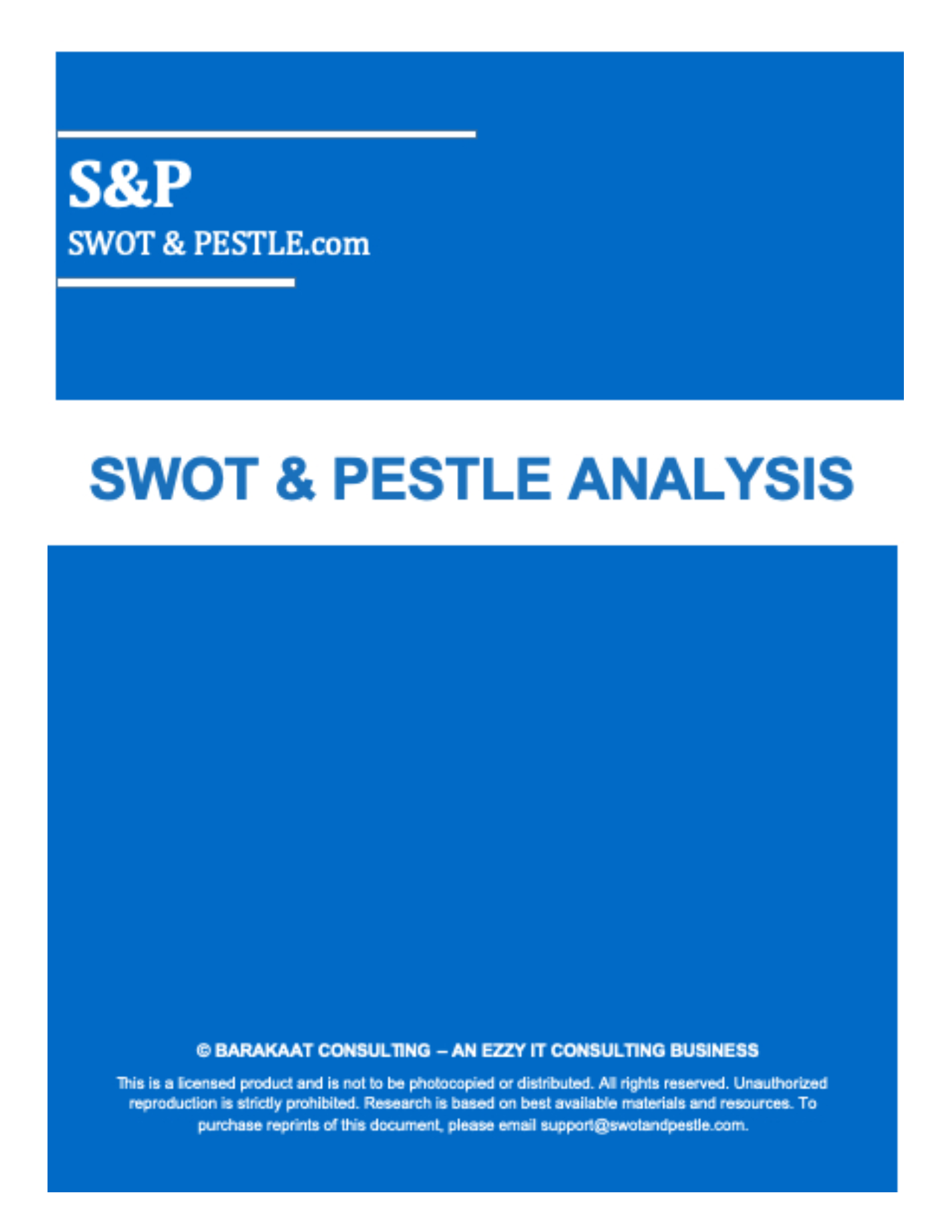

Hennes & Mauritz (H & M) SWOT and PESTLE Analysis
Company profile - hennes & mauritz (h&m), business sector : fashion retail, clothing and accessories, operating geography : sweden, europe, global, about hennes & mauritz (h&m) :.
Hennes and Mauritz, better known as H&M is a multinational company which was started in 1947 in Swedish city Vasteras. It serves as a fast-fashion house for men, women, and children. It has been in operations for the past 76 years and ever since it has grown tremendously. It is the second largest global clothing retailer and has expanded its market across the globe and is a very popular name for quality clothing. It provides a wide range of selection to consumers. H&M’s business strategy is to offer fashion and quality at the best price in a sustainable way. Another important aspect of H&M’s growth strategy is to develop new brands to meet requirements of new customers. In 2023, H&M is taking further initiatives to improve sustainability in all parts of the world. The H&M Group includes eight brands viz., H&M, COS, WEEKDAY, MONKL, H&M HOME, & Other Stories, ARKET and AFOUND, together these brands offer men, women, and even babies a broad variety of products ranging from fashion, beauty, accessories, and homewares. It also has business venture with Afound, Treadler, Singular Society, Creator Studio and majority-owned Sellpy. Besides thousands of offline stores in across 79 countries, the company also has a strong online presence with online shopping available in 58 markets. H&M has 150,000 employees as of 2023.
The Unique Selling Proposition or USP of H&M lie’s in being the second largest global clothing retailer, just after Inditex. Hennes and Mauritz’s (H&M’s) vision is to “use its size and scale to lead the change towards a circular and renewable fashion industry, all while being a fair and equal company.” H&M's mission is to “offer their customers fashion and quality at the best price.”
Hennes & Mauritz (H&M) Revenue :
Competitive analysis of hennes & mauritz (h&m).
- Debit/Credit card

Detailed SWOT Analysis of Hennes & Mauritz (H&M)
2. High customer satisfaction due to product transparency: The brand offers a wide array of choice in contemporary styles keeping in mind the young buyers who look for both affordability and fashion. The brand brings about a connection in youth and keeps itself in line with the high street design. The brand recognizes itself as value for money. The products are durable, smart and keep in mind the choices and needs. Thus, they rate high on customer satisfaction. This is one of the biggest strengths as it can have a loyal customer base that identifies with the brand. Higg Index tool is used by H&M for product transparency. It is available for a wide range of products in markets which informs its customer about the environmental impacts of the materials used in the products. This only increases customer satisfaction as they remain concerned about the environment.
The remaining section under "Strength" is available only in the 'Complete Report' on purchase.
This section is available only in the 'Complete Report' on purchase.
Opportunity
Detailed pestle analysis of hennes & mauritz (h&m).
1. Navigating economic challenges and shifting consumer dynamics: The global fashion industry in 2023 faces economic challenges and evolving consumer behaviours, marked by hyperinflation and subdued consumer sentiments that hindered previous growth momentum. The luxury sector, driven by affluent consumers in regions like China and the United States, is set to achieve 5% to 10% growth, while the non-luxury fashion market may experience modest growth of -2% to +3%, varying by region. Inflation, escalating material costs, macroeconomic uncertainties, and geopolitical tensions disrupt operations and supply chains. Prudent consumers cut spending, while luxury consumers remain less affected. Fashion companies, including H&M, must adapt operational models, supply chains, and marketing strategies to navigate economic complexities and changing consumer preferences. Amid uncertainties, strategic realignment is crucial for the industry's success in 2023.
The remaining section under "Economic" is available only in the 'Complete Report' on purchase.
Technological
Environmental, major brands :.
- Cheap Monday
- H&M HOME
WHY BUY THIS REPORT?
Table of contents, delivery and format, why choose us.

You may also be interested in other analyses of Hennes & Mauritz (H&M):
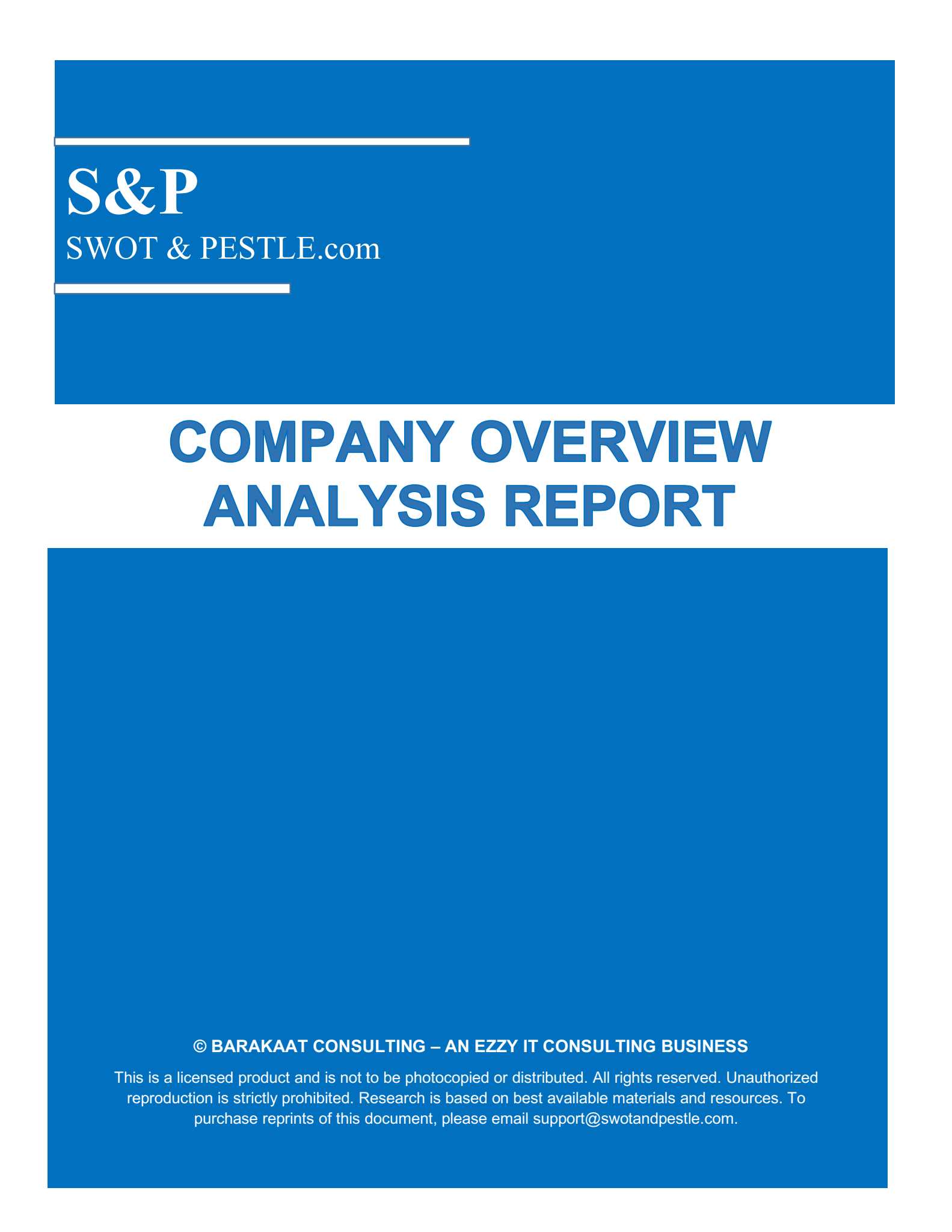
Check Out Analysis of Other Relevant Companies
References used in hennes & mauritz (h&m) swot & pestle analysis report.
1. Annual and Sustainability report 2022 - https://hmgroup.com/wp-content/uploads/2023/03/HM-Group-Annual-and-Sustainability-Report-2022.pdf 2. Statista.com - https://www.statista.com/topics/871/online-shopping/#topicOverview 3. General news 2023 - https://about.hm.com/news/general-news-2023/inspiring--expressive---fun---h-m-home-invites-you-back-to-schoo.html 4. Home furniture lamps launch - https://www.thezoereport.com/living/hm-home-furniture-lamps-launch The detailed complete set of references are available on request in the 'Complete report' on purchase.
How to Reference This Page?
You can use the following in your reference section in order to give credit to the source. For different referencing styles and detailed guidelines, please click here .
Hennes & Mauritz (H & M) SWOT and PESTLE Analysis - SWOT & PESTLE.COM
SWOT & PESTLE.com (2024). Hennes & Mauritz (H & M) SWOT and PESTLE Analysis - SWOT & PESTLE.com. [online] Available at: https://www.swotandpestle.com/hennes-mauritz-hm/ [Accessed 23 Apr, 2024].
In-text: (SWOT & PESTLE.com, 2024)
Copyrights and Disclaimer
Hennes and Mauritz SWOT and PESTLE analysis has been conducted and reviewed by senior analysts from Barakaat Consulting.
Copyright of Hennes and Mauritz SWOT and PESTLE Analysis is the property of Barakaat Consulting. Please refer to the Terms and Conditions and Disclaimer for usage guidelines.
You might also like to check out :
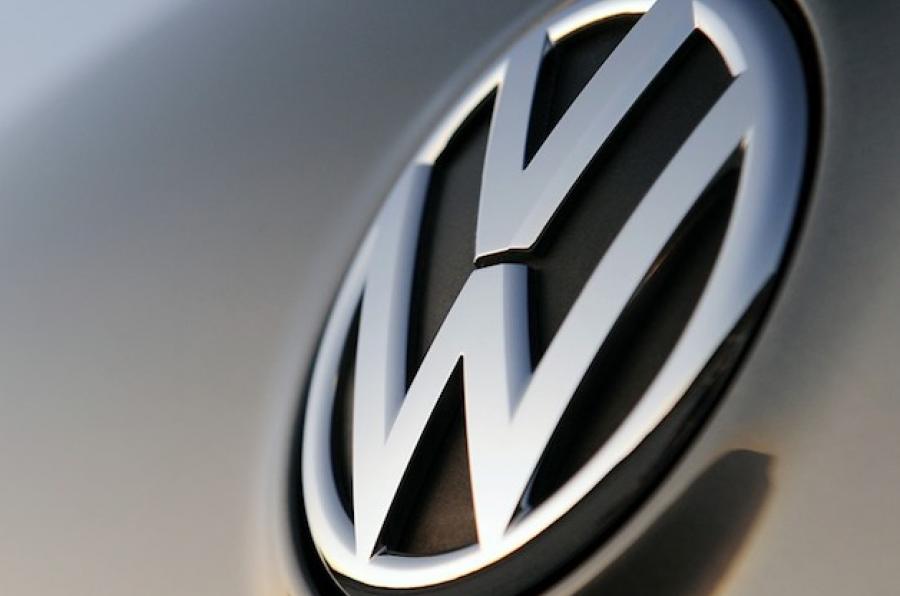
Jul 08, 2019

Sep 20, 2019

Sep 21, 2019
Other Companies in Europe
- Colas Group SWOT and PESTLE Analysis
- SPIE SA SWOT and PESTLE Analysis
- Ubisoft Entertainment SA SWOT and PESTLE Analysis
- Primark SWOT and PESTLE Analysis
- Trigano SA SWOT and PESTLE Analysis
ADVERTISE WITH US
Reach thousands of academicians and corporates. Grow your business.
Need Strategic Analysis for this company? Porter’s, BCG, Value Chain...
TESTIMONIALS
I found the analysis reports of SWOT & PESTLE.com very comprehensive and insightful. I have used them in a lot of my personal research work. -Mudassir Khan Accounting and Business, Melbourne Polytechnic
Here the research is to-the-point, no beating round the bush. Cuts down my effort to surf through heaps of redundant data. -Alexandra Mooki Major in Business Administration, Carnegie Mellon University
This website has an amazing support team. They helped me with my custom research and delivered before time! Keep it up!! -Keith Grencher Birmingham Business School
ORDER A CUSTOM REPORT
Are you looking for a report which is not covered on our website?
Do you want us to design a market survey or write a market research report as per your specific requirements?
Reach thousands of academicians and corporates across the globe. With high ASD, your ad post will be displayed across all our 2500+ pages. Grow your business with effective advertisement!

Swedish multinational company H & M Hennes & Mauritz AB or H&M is one of the largest clothing retailers in the world and one of the most prominent clothing and apparel brands in the global market. It operates in more than 70 geographical markets with more than 4800 physical stores and more than 10700 employees. This article explores the internal and external factors affecting the business of H&M using the SWOT framework .
Situational Analysis of H&M: A Discussion of Internal and External Factors Relevant to Its Business Using the SWOT Framework
1. strengths.
H&M banks on the fast-fashion business model similar to competitors such as Zara and Shein . It is one of its sources of competitive advantage. The company also has a fashion-forward philosophy that compels it to design, produce, and sell products based on the latest trends in the market. It has also expanded its product portfolio beyond clothing and apparel.
Below are the specific strengths of H&M:
• Efficient Production Through Fast-Fashion: The fast-fashion model allows the company to mass produce its products for mass consumption at a faster rate and cheaper cost compared with the manufacturing processes of traditional clothing and apparel brands while taking into consideration the latest trends in design.
• Penetration Pricing as Value Proposition: Another strength of H&M comes from the cost-efficient fast-fashion production that enables it to utilize penetration pricing . This pricing strategy allows it to maximize its market reach and compete against high-end fashion brands and even other established casualwear brands.
• Expansion and Diversification of Portfolio: The company has also expanded its product portfolio. These include different categories of clothing and apparel such as casualwear, sportswear, and footwear, among others to compete against alternative and substitute brands. It also has homeware products.
• Strong Supply Chain and Distribution Network: Its approach to supply chain management has factored in the importance of sustainability which takes into consideration waste reduction, low energy consumption, and recycling. It also has a solid global distribution network composed of physical stores and an online store.
• Collaboration with Designers and Celebrities: An interesting aspect of its promotional strategy is its partnerships with designers and celebrities. The company has collaborated with known fashion designers such as Jimmy Choo and Alexander Wang, fashion houses such as Versace and Kenzo, and celebrities like Madonna.
2. Weaknesses
The overall business of H&M and its different strategic approaches have some shortcomings. Some of these are even a source of its weakness. The company lacks vertical integration unlike Zara and remains dependent on outsourcing. Furthermore, because of its fast-fashion business model, its designs depend too much on the latest trends.
Below are the specific weaknesses of H&M:
• Overdependence on Suppliers or Outsourcing: The company lacks a vertical integration strategy. It does not have in-house production capabilities because it outsources most of its production requirements to hundreds of independent suppliers in Europe and Asia. This strategy creates supply chain risks,
• Lack of Innovation Due to Uninspired Designs: Another weakness of H&M is that it has never seen itself as a trendsetter. It remains reliant on the fashion trends set by major designer brands or fashion houses. Some of its designs are even too generic unlike other fast-fashion brands such as Zara and Primark.
• Controversies and Notable Ethical Issues: The company has struggled with its corporate social responsibilities . It figured into several controversies in the past including alleged racism and cultural appropriation, greenwashing, and labor rights abuses in its outsourced production facilities, among others.
3. Opportunities
Remember that H&M is a fast-fashion retailer. However, Zara remains the dominant fast-fashion company while companies like Shein are building their competitive advantages using digital communication technologies. The strengths of some of its top competitors present an opportunity for the company to expand its market share and maximize its earnings potential.
Below are the specific opportunities for H&M:
• Optimization of Production and Operation: The company can benefit from adopting key supply chain management and production strategies such as vertical integration and production automation to resolve its problems regarding its overdependence on suppliers or outsourced manufacturers and labor rights issues in the past.
• Improved Product Development and Marketing: Another opportunity for H&M rests on an innovative approach to designing and producing clothing and apparel products. It can partner with celebrities, fashion designers, and even other brands to develop unique and fashion-forward designs with mass-market appeal.
• Building Further Its E-Commerce Platform: Its existing e-commerce platform or online storefront can be improved further. It has an established brand name and resources needed to compete with companies such as Shein. It can also experiment with the value-adding benefits of artificial intelligence. and augmented reality.
H&M operates in a highly competitive environment . Industry rivalry is intense due to factors such as the presence of differentiated brands and low entry barriers that create a threat from new entrants , the threat that comes from substitute brands and products, and the bargaining power of consumers and the bargaining power of suppliers .
Below are the specific threats to H&M:
• Threat From Online-Enabled Brands and Entrants: Shein has demonstrated that it can compete against other fast-fashion retail giants at less cost by maximizing the benefits of electronic commerce instead of traditional distribution channels such as company-owned or company-licensed brick-and-mortar stores.
• Presence of Counterfeits and Unbranded Products: Another threat to H&M is the presence of counterfeits or fake products sold on the black market and even on reputable electronic commerce platforms. There is also an abundance of unbranded clothing and apparel products that can be purchased offline and online.
• Rising Costs Associated With Production and Operations: Several costs threaten the profitability of the company. These include the costs of purchasing production inputs or raw materials, labor costs in its outsourced production facilities, shipment and other costs associated with logistics, and rent for its physical stores.
• Impact of Economic Downturns and Market Slowdowns: Fast-fashion brands target consumers that are sensitive to price. Economic downturns and market slowdowns affect the purchasing powers of these consumers and can compel them to switch and choose alternative products and even substitute products.
• Mounting Criticism Toward Fast-Fashion Companies: There is an increasing activism against companies engaged in fast fashion. This business model has been criticized due to its unsustainability or negative impacts on the environment, as well as for imitating designs from notable fashion houses and fashion designers.

H&M’s SWOT Analysis

Hennes & Mauritz AB comes in the second-largest company globally in the world of fast fashion; this is largely attributed to H&M’s fast-fashion strategy that gives the company a huge competitive advantage over others in the industry.
From humble beginnings with just one store over 65 years ago, H&M has grown into a force to reckon with on the globe with thousands of stores spread around 6 continents. There is therefore a lot to learn from the growth journey of this great company. We now present H&M’s SWOT analysis. Before we go further into detail about H&M’s SWOT analysis, let’s see the brief overview of the company as follow:
Company Overview
Now let’s see the detail of H&M’s SWOT analysis which consists of the internal analysis of strengths and weaknesses as well as external analysis on opportunities and threats.
H&M’s Strengths
An effective strategy.
H&M uses the fast fashion model to supply the latest trends to designer tables. The fashion industry relies on effective selling strategies to ensure a higher turnover, more cash flows, and higher revenues. This strategy shortens the duration of the delivery time for delivering merchandise from the designer tables to the boutiques and showrooms.
Global presence
H&M started its path on global expansion in 1964 having its first foreign stores in Norway. H&M has now grown to more than 5,000 stores in the 6 continents globally in its 74 markets. The company’s global operations help diversify risk. The company envisions growth of 10% – 15% growth per year
Geography diversification
Geography diversification is a great strategy in reducing dependence on one geographic region. The US market has the largest store count for the company stores but it only accounts for 10% of the total store count for the company. Germany is a critical market for the company but it also accounts for 15% of the total company store count
Huge cash flows
With the fast fashion business model, the company has been able to keep its operating cash flows above board ranging from SEK 20 billion – SEK 29 billion.
Strong appreciation for sustainability
The company’s policy is to use organic cotton which it has done for years. It has gone a step further to invest in the production of organic cotton through a global initiative called ‘Better Cotton Initiative’. The company enlightens organic cotton growers with better techniques for production. Another strategy that the company uses is zero waste production by maximizing on recycling of waste products.
Competitive pricing
The company strives to be sustainable. Even with the high cost of production, the company strives to offer its quality products at affordable prices. It is important to always be sensitive about pricing because regardless of the product, the price really matters.
Wide product range
A wide product range gives customers a chance to choose from many choices and therefore limits the customers from going after other brands in search of other options. the brand’s product line includes apparel, shoes, cosmetics, boiled egg, pots, blankets, candle holders, and blankets among others. The company also has unique sub-brands like H&M, Cheap Monday, and ARKET
Valuable brand
From its inception, the company has had a single eye for customer satisfaction. With this principle, the company has grown into a valuable brand; it is rated 8 on the apparel 50 2021 ranking by Brand Directory.
A strong online presence
With the internet being ubiquitous, companies that adopt an online strategy and exploit it effectively have a huge advantage over their competitors.
An efficient supply chain
A global company definitely requires an efficient supply chain for seamless delivery and for a great customer experience. H&M’s supply chain is NextGen and is therefore highly efficient.
H&M’s Weaknesses
Falling profit margins.
While the company sales have kept on increasing year over year by double-digit growth rates, the company’s profit margins have kept on dropping, even much more with the pandemic.
Dependence on outsourcing
H&M does not do in-house manufacturing, the company depends on over 900 independent suppliers in Asia and in Europe. While this has been the bedrock of the company’s success, it predisposes the company to unscrupulous suppliers. It gives H&M weak control of the desired quality of products for its customers.
Inventory challenges
Brands which do in-house manufacturing are able to fluctuate their inventories in a short time depending on the demand in the market. H&M relies on outsourcing and therefore its supply chain is not flexible and responsive enough and with speed to changes.
Controversial products
The company got controversial in 2018 when it advertised its hoodie featuring a black child model dressed in the hoodie with the inscription “Coolest Monkey in the Jungle”. This attracted the wrath of customers from across the globe who chose to boycott the company’s products for promoting racism.
Lack of inspired fashion
H&M relies on fashion trends set by major designer brands for them to decide their choice of merchandise. Unfortunately, most fashionistas are drawn novel designs that are radical
Rising operational costs
Globally, the costs of labor and transport have significantly gone high. In addition, H&M’s center of production is far away in Asia while its key markets are in Europe. This is not only time-consuming but becomes costlier. The delay time delays response time to the changes in the market.
H&M’s Opportunities
Emerging markets.
There is a growing market in emerging markets of middle-income households who like fashion and style and could afford it.
Expansion through mergers and acquisition
Mergers and acquisitions present a great strategy to penetrate into markets that would otherwise present barriers to entry for foreign companies. H&M could make use of these opportunities to expand their markets to emerging economies like Asia and Africa. It could expand by consideration of secondhand clothes.
More focus on e-commerce
When compared to other fashion retailers like Zara, H&M still have a long way to go in fully exploiting the benefits that online retailing has to offer. E-commerce will enable the company to push sales through their online channels during these pandemic times when physical in-store sales are dwindling due to COVID 19.
H&M’s Threats
Looming recession.
While clothing is a basic human need, fashion and style are basically considered as luxury. As such, fashion houses and retailers need to consider the threats of recession which may sharply impact on their sales negatively.
Stiff competition
The fashion and style industry is rife with stiff competition, H&M faces competition both from new and old companies like Zara, Boohoo, and Macy’s among others.
Trade regulations
Given H&M is an international company; it is bound to strive with different trade regulations. Much more, since the company is Swedish, it could easily fall victim to the aftermath of Brexit.
The success of companies like H&M largely depends on the free flow of raw materials and merchandise. Lockdowns and quarantine threaten the free flow of these materials and merchandise.
With diminishing margins, low control over the quality of their products, and an impending recession, H&M needs to make the most of its opportunities for growth to ensure more margins.

Related Posts
What is swot analysis and why it is important, swot analysis for walmart.
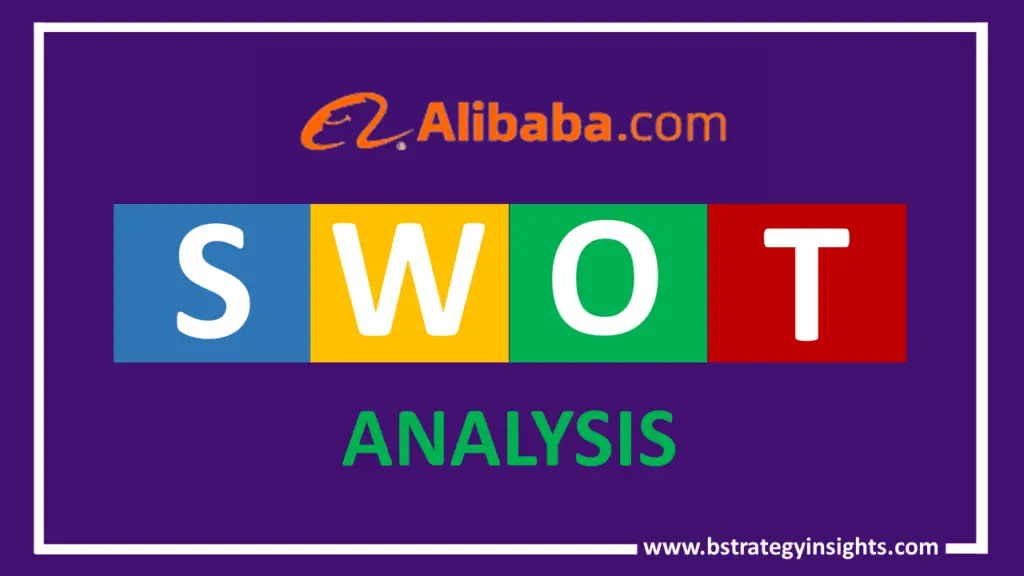
Alibaba SWOT Analysis

- Calculators
- Swot Analysis
- Pestle Analysis
- Five Forces Analysis
- Organizational Structure
- Copywriting
- Research Topics
- Student Resources
Services We Provide

Resources We Provide

Login / Register

- A Well Conducted and Comprehensive SWOT Analysis of H&M
- H&M Overview
Hennes & Mauritz AB (STO: HM-B) also known as H&M is one of the most renowned brands all over the globe. This Swedish clothing retailer brand was originally founded in 1947 and today the company holds 4,743 stores in over 50 countries. Although H&M is one of the biggest retail players in the clothing industry, in order to maintain its competitive advantage, the company needs to constantly work on strengthening its internal capabilities. That being the case, in order to optimize its strengths, eliminate its weaknesses, grab the opportunities, and prevent threats, the company needs to conduct an effective SWOT analysis.
To elaborate, SWOT analysis is an effective management tool that can assist companies in determining their internal strengths, weaknesses, opportunities, and threats. These identified factors can assist companies in optimizing their core competencies and gaining a competitive edge over their competitors.
That being the case, this blog will effectively highlight the SWOT analysis of one of the most prominent clothing brands in the world, H&M. Additionally, if you want to gain extensive insights on SWOT analysis, you can have a look at our complete and extensive SWOT analysis guide . Till then, let’s get started with an in-depth H&M SWOT analysis.
Table of Contents
Strengths of h&m, weaknesses of h&m, opportunities for h&m, threats for h&m, extensive and detailed swot analysis of h&m.
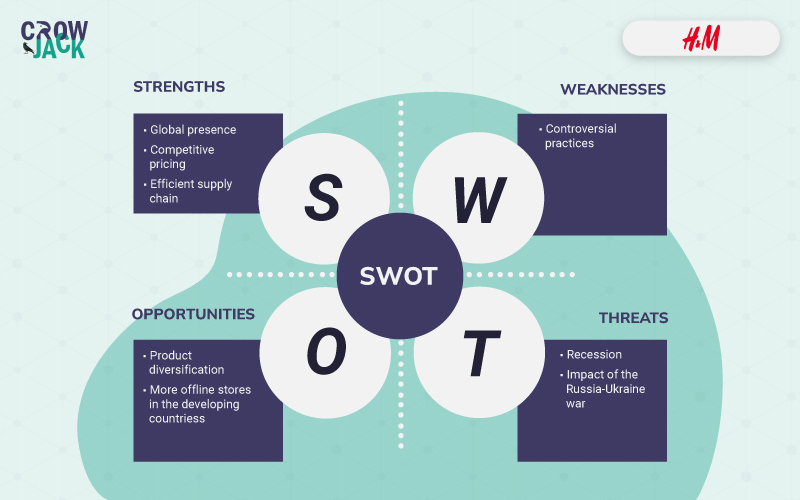
Global presence- H&M group has an extensive presence across the top economies of the world. Its portfolio consists of brands like H&M, COS, Monki, Weekday, & Other Stories, ARKET, Afound, and H&M Home. All these brands have physical stores as well as online markets except the Afound which is just available online. The total store count as per the company’s website is 4702 and has a presence in 76 countries. Further, the company is considered to be the fourth most valuable apparel brand after Nike, ZARA, and Adidas as per the findings of Statista .
Competitive pricing- One of the major advantages of H&M is that its prices are low as compared to the competitors even though it is considered a luxury brand. As per the article on LinkedIn , the company is able to keep the prices low by outsourcing most of the manufacturing to the manufacturers in countries that have cheap labor. For example, the products that are sold in Europe are mostly manufactured in Turkey and the basic product range gets manufactured in Asian countries.
Huge variety of products- H&M deals in various products that include sportswear, underwear, cosmetics, accessories, and shoes while it caters to different segments such as men, women, teenagers, children, and babies.
Strong online presence- H&M has its own online marketplace in around 54 markets. Further, the company has also tied up with different third-party e-retailers such as Myntra in India (Crossley, 2019). Further, it is also experimenting with selling products of other brands such as Crocs, Fila, Lee, and Wrangler on its website in two countries, Sweden and Germany (Anderson, 2022).
Efficient supply chain- H&M’s has a huge supply chain network that consists of over 602 suppliers and 1519 factories along with effective change management capabilities. The network is scattered across different nations from Africa, Asia, Europe, and North America. Further, the company works on the principle of transparency and is a member of the transparency pledge. The details of all the suppliers are disclosed in the public domain including the name of the supplier, the location, and the product type (H&M, 2022).
Further, the company has formulated a supplier’s code of conduct that require the suppliers to purchase the textile from the manufacturers that produce it in a sustainable manner and the suppliers must adhere to ethical standards such as payment of fair wages to the workers, no deployment of forced or child labor. In addition, inventory management has been made much more efficient by the use of artificial intelligence for the forecasting of demand and this has resulted in a decline in waste of the clothing (Britt, 2020).
Effective organizational structure- H&M functions through a matrix organizational structure wherein there are multiple brands and each brand is controlled by a different individual and each one of them has its own respective sales team. This organizational structure is beneficial for the organization as there is efficiency in communication and also each employee is clear about their role and objectives in the organization.
Controversial practices- H&M has been in the news many times for all the wrong reasons. In 2018, the company had to face protests because of its racist advertising wherein a black child was wearing a sweatshirt with the slogan that read “coolest monkey in the jungle”.
As a result of such ethical issues , the company’s stock prices declined to a great extent and its stores were vandalized along with many celebrities severing ties with the brand. This ad was the result of the lack of focus of the company on the aspect of diversity and most of its staff in Europe was white (Byrne, 2022).
Further, the company has also been accused of making false claims about the sustainability of its products. One of its products named Antoinette dress was said to have used 20% less water than the baseline, however, the investigation revealed that the usage of water was actually 20% more.
Hence, these practices reflect the urgent need for the company to shift its focus on sustainability which can include more recruitment of employees from diverse backgrounds in the workforce, and training the employees so that they can be more sensitive towards employees with different needs. Also, the company must focus on environmental sustainability and be more transparent and honest toward the customers.
Product diversification- H&M is already an established brand in apparel and it can exploit the opportunity by venturing into sports apparel which would make it possible for the company to attract more customers. A well-framed business diversification strategy will help the company acquire a larger market share in emerging markets.
More offline stores in the developing countries- Although H&M is already setting up its offline stores in developing countries, it can even come up with more and more offline stores in other developing countries as well to attract new customers and earn high profits contributing to the growth of the company.
Recession- As per the analysis by CNBC , a few of the powerful economies in the world are on the brink of recession including the US, UK, and Europe. It is predicted that these economies would go into recession in the coming 12 months owing to the consistent slow growth over the years. The slow growth in these economies would lower the sales of H&M.
Impact of the Russia-Ukraine war- H&M has been at the receiving end because of the war between Russia and Ukraine. As per the Financial Times , the company has now closed 185 stores in Russia, Ukraine, and Belarus. This could have an impact on the company in the long run as before the war, Russia was the sixth largest market for H&M and accounted for 4% of the group sales.
To conclude, H&M has a strong market with customers from all segments and it focuses highly on its supply chain. However, the company has been involved in various controversial practices related to racist products and environmental sustainability which it can improve by training the employees about diversity and employing more people from diverse backgrounds. It also needs to be more honest and transparent towards its valuable customers or else its brand image and value can decline. Besides, H&M PESTLE Analysis gives a more detailed overview of how external business factors affect the company.
Recommended Readings
Adidas SWOT Analysis
Zara SWOT Analysis
Nike SWOT Analysis
Anderson, G. (2022). H&M opens its e-commerce site to third-party clothing brands. retailwire.com. Retrieved 28 July 2022, from https://retailwire.com/discussion/hm-opens-its-e-commerce-site-to-third-party-clothing-brands/ .
Britt, H. (2020). The H&M Supply Chain Could Be the Model to Follow in Making Fast Fashion Sustainable. www.thomasnet.com. Retrieved 28 July 2022, from https://www.thomasnet.com/insights/h-m-supply-chain/.
Crossley, I. (2019). H&M expands online presence by launching on Myntra. in.fashionnetwork.com. Retrieved 28 July 2022, from https://in.fashionnetwork.com/news/H-m-expands-online-presence-by-launching-on-myntra,1129131.html.
Byrne, C. (2022). The H&M Marketing Controversy. stockton.edu. Retrieved 28 July 2022, from https://stockton.edu/diversity-inclusion/h-and-m-marketing-controversy.html.
H&M. (2022). Supply chain. hmgroup.com. Retrieved 28 July 2022, from https://hmgroup.com/sustainability/leading-the-change/transparency/supply-chain/.
Sign up for our Newsletters
Enter your email address to register to our newsletter subscription delivered on a regular basis!
Copyright © 2023 CrowJack. All Rights Reserved
- H&M SWOT Analysis
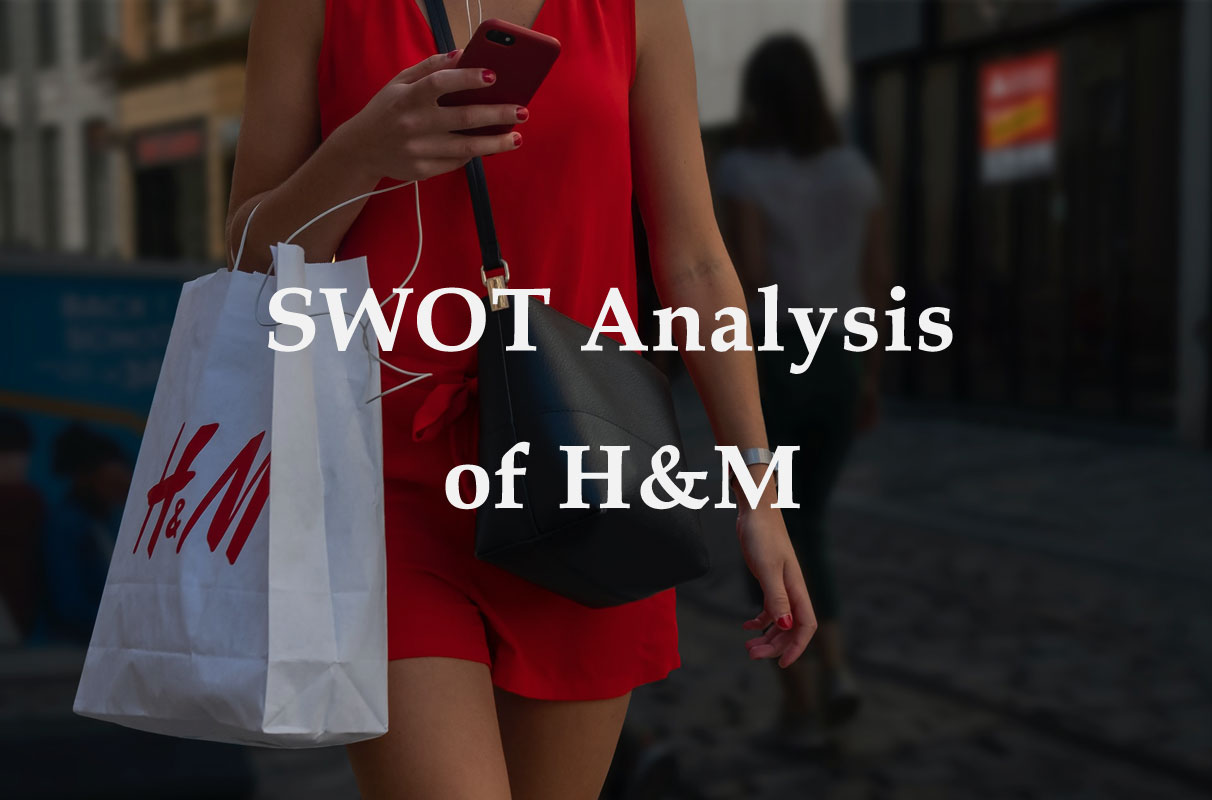
Introduction
Hennes & Mauritz AB, more recognizable in the world of fashion as H&M, is a global company engaged in the manufacture of high-quality apparel and is one of the top brands in fashion today. The company originated in the town of Vasteras in Sweden when it was established by Erling Persson. Today, it still has its head office in Sweden, but it now operates more than 5,000 stores in over 70 countries all over the world.
H&M is known to sell very trendy clothing. Although it has selections for just about anybody, its customer base is made up largely of young, hip millennials. One of the most interesting things about this company that not many people know is that it does not manufacture its clothes. Despite having thousands of stores around the world, H&M does not own any production facility and instead relies on top suppliers from Asia for its products. It's the secret for maintaining a steady stream of products at a rapid pace and relatively affordable prices, also known as the fast-fashion strategy. Now, look at the description for H&M SWOT below.
H&M SWOT Analysis Mind Map
Understanding the success of H&M as a fashion brand can definitely begin with a simple analysis of its strengths and weaknesses, as well as studying the opportunities and threats that it faces in the industry. Besides reading about these elements in detail, it would also help to have a more visual representation, like a mind map. Take a look at the following example that represents the H&M SWOT analysis in mind map (made by EdrawMind ).

Fast Fashion Strategy
- Global reach
Affordable Pricing
Product diversity, well-organized supply chain, formidable online presence, people-oriented approach, excessive outsourcing, fashion conformity, controversial designs, opportunities, better ecommerce strategies, brand expansion, emerging markets, strong competitors, fakes and imitations, higher production costs, h&m's strengths:.
The fast-fashion model is the new thing in the retail clothing industry. It is where the company fast-tracks production and releases a new collection to the market every two weeks or so, giving customers new choices whenever it visit the stores. This is in contrast to the usual method of seasonal production that involves a wait of 4 to 6 months before a brand's new collection comes out.
Wide Global Reach
H&M is not lacking at all in its efforts to reach the global market. With more than 5000 stores in 6 continents, H&M is adequately represented in more than 70 countries. It has a firm hold in the international market and is continuously broadening its reach by tapping new markets.
This Swedish fashion brand does not have its own production facilities. Instead, it works with multiple suppliers that provide H&M with top-quality apparel for a low labor cost. While some may frown on this potential lack of control over production, this system is actually very cost-efficient and allows them to sell its goods at lower prices.
Initially, H&M focused on selling women's clothes, but it has since expanded its product range and now has something for everyone. Furthermore, it has also gone beyond clothing and accessories. In almost all of its stores, H&M now also offers cosmetics, shoes, linen, and even home décor.
One of the advantages of partnering with multiple suppliers is that there is very little chance of having low supply issues. H&M keeps all its stores well-stocked with its current offerings, and whatever supply issues it encounters are very quickly resolved.
H&M has a good eCommerce strategy that sufficiently caters to the online market. Aside from its official website, it also uses third-party platforms to help reach more online shoppers and generate more eCommerce sales.
Since it was established almost 65 years ago, H&M has always maintained a people-oriented culture, both internally and in dealing with customers. It is quite involved in the community and takes an active stand when there are issues that it feels strongly about.
H&M's Weaknesses:
Unlike some of its close rivals in the retail fashion industry, H&M outsources all of its clothing. This strategy does have its advantages, but it also limits the control that the brand actually has over the production process. Problems that arise in the supplier's facilities can also cause drastic damage to the sales and operation of the company.
The clothes sold by H&M are always trendy and of high quality, but they mostly just follow the current fashions. Many of the items are patterned after other designers' products. They do not have original designs that bear a distinctive H&M look.
It may be a one-time occurrence, but it is going to be difficult to forget the 2018 incident where H&M produced a hoodie with the words "Coolest Monkey in the Jungle" and used a black child to model it. After being called out for racism and being boycotted worldwide, the fashion company might have learned to be more careful in approving apparel designs.
H&M's Opportunities:
The online market has already been growing at a steady pace, but when the pandemic began, and people were forced to stay home, more consumers discovered the benefits of online shopping. H&M already has a robust online presence, but there is still much room for improvement, especially now that the online market is growing at a faster rate than ever.
H&M has built a solid reputation as a high fashion brand. If it suddenly starts selling items outside this sphere, like secondhand clothing or sporting goods, it might confuse customers and even lead to a decrease in sales. But it can still expand through mergers and acquisitions.
Fashion retailers like H&M focus mostly on the upper-class market. But there are several emerging markets that show great potential for sales, and it would benefit the company to look into these prospects.
H&M's Threats:
The fashion retail industry has plenty of competitive players, and H&M will have to find ways to stay ahead of them.
There is a growing trade in fakes and imitations in the fashion world. As counterfeiters get better, sales of premium brands like H&M might drop considerably.
The cost of material and labor has been increasing, and even more so in recent years. This is an uncontrollable factor that can reduce the profitability of H&M's products.
Key Takeaways
Over the last 65 years, H&M has carved a name for itself in the retail fashion industry as one of the more reputable and most trusted brands in the business. In this H&M SWOT analysis, we can see that the strengths of the company far surpass the weaknesses. It will not be difficult for the brand to draw on its strengths to seize the opportunities that may be presented to them. Also, the threats that it faces are not that worrisome because these are the same obstacles that stand in the way of most of the other companies in the industry.
Using the same analysis methods that we did above, you can also examine your own corporate strategies and get a clear picture of how your business has been performing. You can build a better and more accurate representation of your own SWOT analysis by using the EdrawMind mind mapping software. It has pre-built templates designed specifically for SWOT analysis that you can use either right on the browser or in a downloadable software application. Either way, you will enjoy the same versatile tools to help you create the most comprehensive analysis possible.
- H&M SWOT Analysis: 7 Threats Hennes & Mauritz is Facing
- In-Depth SWOT Analysis of H&M | Strengths Weaknesses Opportunities & Threats
- SWOT Analysis of H&M: Strengths & Weaknesses 2021
- SWOT Analysis of H&M in 2022
- SWOT Analysis of H&M
- H&M SWOT Analysis, Competitors & USP

Zara Mission and Vision Statement Analysis

Zara Marketing Mix (4Ps) Analysis

SWOT Analysis of Zara

Adidas Mission and Vision Statement Analysis

KFC SWOT Analysis

Nike Mission and Vision Statement Analysis
- Skip to primary navigation
- Skip to main content
- Skip to primary sidebar
PESTLE Analysis
Insights and resources on business analysis tools
H&M SWOT Analysis: 7 Threats Hennes & Mauritz is Facing
Last Updated: May 24, 2023 by Abdul Momin Filed Under: SWOT Analysis , SWOT Examples
Hennes & Mauritz AB, better known as H&M, is one of the biggest names when it comes to fast fashion in the modern world. Fast Fashion is a trend that refers to replicating clothes from expensive brands in a short amount of time and by using cheaper fabrics and labor. Not only has this made clothes less costly for consumers, but it has also reduced costs and increased profits for the producers.
H&M’s story inspires many. From a single store in Sweden that was started more than 65 years ago, the brand has transformed itself into a leading multinational that is second only to Inditex when it comes to global clothing retailers. Today H&M is operating in 74 countries and has online shopping available in 33 of those. It has over 5,000 stores with clothing for men, women, teenagers as well as children. Erling Persson started the company, and today it is run by his son Stefan Persson along with Helena Helmersson.
By using strategic focus areas, the company has managed to make a name for itself and come up as one of the biggest names in fashion retail . It does not manufacture its own clothes; instead, it sources them from other suppliers in Asia. Fast fashion is the main reason that the brand has managed to create such profits for itself as well as procure an image. Whenever someone talks about fast fashion, H&M is one of the first names to be mentioned.
Due to its unique success story, undertaking a SWOT Analysis of H&M will help understand the brand on a deeper level.
What are some of H&M’s strengths?
A wide variety of products.
H&M started with selling only clothing that too just for women. Today, it has branched out and started selling a wide range of products other than clothes as well. The list includes cosmetics, accessories, shoes, blankets, decor pieces, candles, etc.
The company has around eight sub-brands (H&M Home, Monki, Cheap Monday, etc.)that sell these products.
Individual Brand Identity
The eight brands that come under H&M Group are H&M, COS, Monki, Weekday, & Other Stories, Cheap Monday, H&M Home, and ARKET. All of these brands have their own unique identities that people know them by. The H&M group has carefully crafted these identities to target specific consumer groups.
Growing Financial Situation
As discussed previously, fast fashion enables brands to acquire hefty profits, reflecting in H&M’s financial performance over the years. If a brand manages to show fiscal growth, this not only provides financial stability to the company itself but also increases the chances of external investment.
Presence in the Global Market
H&M’s presence in the global market is robust since it is spread in over 74 countries in all of the six continents. The brand has managed to expand its consumer base by always approaching new markets.
Such geographically strategic moves enable the company to develop as a strong competitor to other brands of similar dimensions. The global presence of H&M also brings it sustainability and stability and reduces potential business risks .
Pricing Strategies
Fast fashion brings on board a lot of opportunities for the suppliers to earn the right amount of profits. H&M prices its products in such a way that it gets to sell high-quality products at lower prices which keeps churning in high yields . This strategy works solely because of the fast fashion model that is highly cost-effective.
Strong Online Presence
Considering the technological advancement in today’s day and age, online platforms have become one of the main avenues of marketing for brands . H&M has managed to generate a strong online presence that too one that is spread across various platforms. This really helps with online as well as in-store sales for the brand.
The company has successfully managed to make the most of all the tools at its disposal to ensure that its brand is sustained.
Community-centered and Customer-centric Approaches
H&M focuses on developing a customer-centric model to provide its consumers with a satisfactory experience. Approaches like these have attributed a lot of value to the brand’s name.
The group has also tried to keep itself very community-centered. One can find an excellent example of this from when the brand shut down its stores in support of the protests in the US. Taking an interest in the interests of the community can really help a brand be more sustainable.
What are some of H&M’s weaknesses?
Lack of originality.
Due to its fast-fashion model, H&M relies heavily on current trends and designs by other brands for its products. This situation leads to critics calling the products of the brand not only unoriginal but uninspiring as well. Since everything the brand does has already been done, there is no innovation in the products that might attract fashionistas.
The brand does not come up with its own trends but rather just copies what everyone else is doing.
Ethical Concerns
People often raise many ethical questions on the practices of fast fashion brands. The idea behind these concerns is that it is unethical to steal ideas from other brands in the first place. But on top of that, mass-producing these items using cheap labor is dehumanizing and against fair work principles.
In addition to copying off high-fashion brands, people have also accused fast fashion brands of blatantly ripping off designs from Indie creators without giving them the due credit.
The working conditions in the manufacturing factories that H&M sources its products from are questionable and unjust. Problems like this add to the question of the legitimacy of fast fashion and brands like H&M.
Overdependence on Outsourcing
The fact that H&M outsources all of its products from external producers raises a point of contention. The brand is entirely dependent on these producers, and any halt in their factory production will cause the sales of H&M to drop instantly.
Controversies
Another thing that has become almost a trend with brands like H&M is the list of controversies raised on its products. In 2018, a lot of customers boycotted H&M, and its products after a marketing campaign of theirs was called out to be racist.
Similar incidents have happened with other fast fashion brands as well. The Chinese brand Shein has been under a lot of fire recently on more than one occasion on cultural appropriation charges.
What are some of the opportunities for H&M?
Diversifying its product range.
H&M is already offering a wide range of products. If the brand branches out just a little bit more to bring new products on its list, this can turn out to be very beneficial for its image as well as brand stability.
Online shopping has opened up new avenues for fashion retailers. The brand can turn this into an even more significant opportunity for itself if it starts fully utilizing the resources at its disposal. The e-commerce platform seems to be emerging as the future of the retail industry , which can definitely work in H&M’s favor.
Acquisitions and Mergers
Brands often use acquisitions and mergers to curve competition by creating barriers to entry into the market. The brand can also use mergers or acquisitions to expand into other markets as well.
Expansion Plans
H&M has recently opened up a lot of new stores. Expanding its store base this way can be really beneficial for the revenues of the brand since it will increase sales.
Emerging Markets
H&M currently operates in 74 countries, and there are a lot of new emerging markets that remain untapped by the brand, especially in Asian and African states. By exploring these new markets, the company will be able to raise more profits and expand its consumer base.
More Demand
Standards of living and purchasing power of people are both increasing across the globe. This increases the demand that people have for branded products as they become more brand conscious. H&M can cash in on this opportunity by capitalizing on the higher demand.
What are some of the threats facing H&M?
Fast-evolving trends.
H&M relies on trends and hence also has to keep up with their changing nature. The dynamic of fashion trends are such that they are ever-evolving, but this change has been accelerated with the advent of social media . It has become almost a race to keep up with all the new trends, and if a brand does not keep up, it can risk losing sales.
E-commerce as a threat
If e-commerce opens up new platforms for H&M, it does the same for other brands, even relatively smaller ones. The advent of online shopping has provided smaller brands with an almost equal opportunity to acquire sales. When both of these brands get the chance to be present on the same platform, it can take away from the sales of H&M and distribute them to other brands. This can happen even if those brands are relatively much smaller because these boundaries get blurred during online sales.
Competition
The apparel industry is continually getting new suppliers, increasing the competition, and putting pressure on these brands to always stay on top of their game and keep up with the trends.
Currency Fluctuations
H&M’s reporting currency is the Swedish Krona, but most of its sales come from Dollars and Euros. The fluctuations in international foreign currencies, especially those of developed nations that H&M derives most of its money from, can significantly impact the brand’s profits.
Avoidance of Fast Fashion
The increased activism against fast fashion is a massive threat for H&M and other similar brands. People have started advocating against these companies for many reasons. Many often say that these fast fashion products are cheaply made and hence not durable.
Environmentalists have raised concerns regarding the environmental cost of these cheap products. These products significantly contribute to pollution by their toxic textile waste.
Lastly, people have also started decreasing the use of fast fashion because it exploits cheap labor and copies off of other brands.
Pandemic and Recession
The lockdown that had to be imposed because of the pandemic has affected the flow of products and raw materials from one place to another, which can heavily impact H&M’s sales. The pandemic has also posed an imminent threat of an economic recession which is another factor that can cause the sales of the brand to take a hit.
It is challenging to deal with these problems as well since they are long-term, and there is a lot of uncertainty as to when things will actually get better.
Restrictions in International Trade
H&M is a Swedish company that outsources most of its products from Asia and then sells them globally; it is heavily reliant on International Trade. There are always risks of trade restrictions that can have a considerable impact on a global brand’s sales like H&M if they do get imposed.
H&M SWOT Analysis: Conclusion
H&M has a huge name in the fashion industry and a place that no brand can take away from it. It has developed a brand name for itself that all the consumers know of, making other suppliers hesitant to enter the market.
According to this H&M SWOT analysis, the brand can utilize all of these aspects and other opportunities to its benefit to overcome the threats that it is facing. Furthermore, the dangers in place for H&M are also not novel to the brand only. Other fashion retailers are facing the same hurdles.
Hence, it is not impossible for the brand to turn the situation the other way around by finding innovative solutions to these threats and its own weaknesses. The fast fashion industry has always been a race and will continue to be so. It is now up to brands themselves to realize where they stand in this race and how they are planning to improve their relative position in the global market.

H&M Marketing Mix (4Ps)
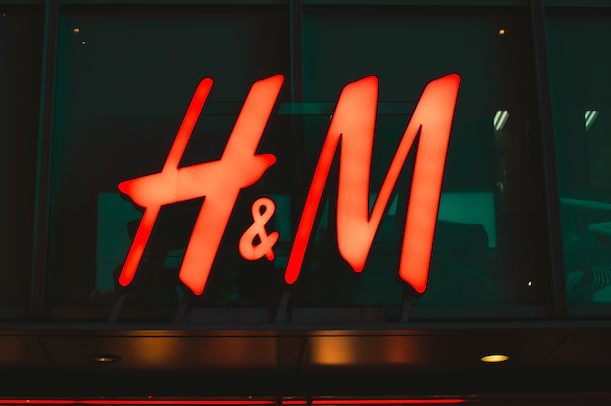
Before we dive deep into the Marketing Mix (4Ps), let’s get the business overview of H&M. H&M, or Hennes & Mauritz AB, is a Swedish multinational clothing-retail company known for its fast-fashion clothing for men, women, teenagers, and children.
Founded in 1947 by Erling Persson, the company has become one of the largest fashion retailers globally, with a presence in over 74 countries and a vast network of physical stores and e-commerce platforms.
H&M offers affordable, trendy, fashionable clothing and accessories catering to various styles and preferences. The company operates under multiple brands, including H&M, COS, Monki, Weekday, & Other Stories, H&M Home, ARKET, and Afound. Each brand targets different customer segments and price points, allowing the company to appeal to a wide range of consumers.
The company’s business model is centered around fast fashion, which involves quickly moving new styles from the catwalk to retail stores. By focusing on efficient supply chain management, design, and production processes, H&M can offer new items at competitive prices.
The brand has also invested in developing a strong online presence, with e-commerce platforms available in several markets, allowing them to reach customers worldwide.
As the company acknowledges the fashion industry’s environmental impact, sustainability has become an increasingly important aspect of H&M’s business strategy.
The brand has set goals to become climate positive by 2040 and to use only sustainable or recycled materials by 2030. H&M has implemented various initiatives to achieve these goals, such as garment recycling programs, investing in sustainable materials, and partnering with other organizations to promote sustainability.
How Is H&M Bringing the Circular Economy to the Apparel Industry?
However, H&M has faced criticism for its role in promoting fast-fashion culture, which has led to increased waste and negative environmental impacts. Concerns over labor practices in the company’s supply chain have also emerged in recent years. In response, H&M has made efforts to improve transparency and conditions within its supply chain and to demonstrate commitment to ethical and sustainable practices.
Financial Performance: For the 2022 financial year, covering the period 1 December 2021 – 30 November 2022, H&M’s net sales increased by 12 percent to SEK 223,571 Mn ($21.4 billion), compared with 2021, at a gross margin of 50.7%.
Here is the Marketing Mix (4Ps) for H&M
A marketing mix, also known as the 4Ps of marketing, is framework marketers use to develop and implement effective marketing strategies. The concept helps businesses identify and optimize the key components necessary to promote and sell their products or services. The 4Ps of the marketing mix are Product, Price, Place, and Promotion.
In addition to the traditional 4 Ps, marketers have expanded their strategies by incorporating additional elements (People, Process & Performance) to help them better understand and reach their target audiences. But we will focus on the 4Ps as they still are the foundation of any marketing strategy. In this article, we will understand the marketing mix (4Ps) of H&M.
By the way, here is a course that will help you stand out in the world of strategy. The Strategic Thinking program for CxO by Cambridge Judge Business School maps your competitive advantage and teaches advanced techniques to formulate, evaluate, and execute winning strategies. Generate winning strategies and learn how to renew them in times of crisis for a competitive advantage.
What is a Marketing Mix? What are the 4Ps of Marketing?
- Product variety : H&M offers a wide range of clothing, accessories, footwear, and cosmetics, catering to men, women, and children. The brand consistently updates its product range, following the latest trends and styles to meet customer demands. H&M also offers various product lines, such as H&M Home, which focuses on home decor and furnishings.
- Product design : H&M is known for its fast-fashion approach, focusing on delivering the latest trends at affordable prices. The company collaborates with top designers and celebrities to create exclusive, limited-edition collections, which help to enhance its brand image and appeal to fashion-conscious customers.
- Quality : While H&M emphasizes affordability, it also maintains a level of quality that keeps customers returning. The brand continuously works to improve its product quality, ensuring that customers receive value for money.
- Sustainability : In recent years, H&M has made significant efforts to become more sustainable, focusing on producing more eco-friendly products, using organic and recycled materials, and promoting ethical labor practices in its supply chain. The company’s Conscious Collection is an example of its commitment to sustainability, offering products made with environmentally friendly materials.
- Brand image : H&M has built a solid global brand image as a fashionable, affordable, and accessible retailer. The company’s product offerings play a key role in maintaining this image, as they cater to various customer segments and showcase the brand’s ability to adapt to changing market trends.
- Competitive pricing : H&M’s primary focus is on offering fashionable products at affordable prices. The company employs a competitive pricing strategy to provide customers with good value for money while maintaining profitability. This approach allows H&M to appeal to a broad customer base and gain a competitive advantage over higher-priced brands.
- Cost leadership : H&M pursues a cost leadership strategy, which involves keeping production and supply chain costs low to offer lower prices to customers. The company achieves this by sourcing materials from cost-effective suppliers, optimizing logistics, and employing efficient production techniques. This approach enables H&M to maintain its low prices and remain competitive.
- Market segmentation : H&M’s pricing strategy also considers different market segments, offering various products at various price points. This allows the company to cater to customers with different budgets and preferences, helping to expand its customer base.
- Dynamic pricing : H&M uses dynamic pricing to adapt to changing market conditions and customer demand. This includes promotional pricing during sales events or clearance sales to clear out inventory and make room for new collections. By adjusting prices accordingly, H&M can maximize revenue and maintain customer interest.
- Value perception : H&M’s pricing strategy focuses on creating a perception of value among customers. The company aims to balance offering affordable prices and maintaining product quality and trendiness. By doing so, H&M can attract price-conscious customers seeking stylish clothing without compromising quality.
H&M SWOT Analysis
- Store locations : H&M operates in numerous countries worldwide, with a significant presence in major cities and shopping districts. The company strategically places its physical stores in high-traffic areas such as malls, high streets, and commercial centers to ensure maximum visibility and accessibility to customers.
- Online presence: H&M has a strong online presence, offering customers the option to shop through its e-commerce website and mobile app. The brand’s online store provides a seamless shopping experience with user-friendly navigation, detailed product information, and secure payment options. This omnichannel approach allows H&M to cater to customers’ preferences and reach a wider audience.
- Global expansion : H&M constantly seeks opportunities to expand its global footprint, entering new markets to reach a broader customer base. The company conducts thorough market research and analysis before entering a new region, ensuring it can cater to local preferences and tastes.
- Supply chain management : H&M’s efficient supply chain management plays a vital role in its Place strategy. The company collaborates with a network of suppliers and logistics partners to ensure the timely delivery of products to its stores and online customers. By maintaining an effective supply chain, H&M can quickly respond to changing market trends and customer demands.
- Collaborations and partnerships : H&M frequently collaborates with high-profile designers, celebrities, and other brands to create unique collections and limited-edition products. These collaborations often generate excitement and buzz around the brand, driving foot traffic to its stores and increasing online sales.
By the way, to communicate our strategy effectively, we all need a robust collaboration platform. Miro is the leading visual collaboration platform. Build anything together on Miro. It’s free and as easy to use as a whiteboard , but endlessly more powerful. Do use the Miro platform for strong communication within your team.
- Advertising : H&M invests in various advertising channels to reach a broad audience, including print, digital, and social media platforms. The company creates visually appealing and trendy ads that showcase its latest collections and brand image, appealing to its target customers.
- Social media marketing : H&M has a strong presence on popular social media platforms like Instagram, Facebook, Twitter, and Pinterest. The brand uses these channels to engage customers, share fashion inspiration, announce new collections, and promote sales events. H&M’s social media marketing efforts help the company to connect with its audience and maintain a strong online presence.
- Influencer marketing and collaborations : H&M frequently collaborates with influencers, celebrities, and designers to create exclusive collections and promote its brand. These partnerships generate excitement and buzz around the brand, driving customer interest and increasing foot traffic to its stores and online sales.
- Sales promotions and discounts : H&M offers seasonal sales, discounts, and promotions to attract customers and encourage purchases. These promotions help the company clear out inventory and create a sense of urgency among customers to take advantage of limited-time offers.
- Public relations and events : H&M engages in public relations activities, such as sponsoring fashion shows, hosting store opening events, and partnering with charitable organizations to enhance its brand image and visibility. These initiatives help the company create a positive brand perception and foster customer goodwill.
- Email marketing and loyalty programs : H&M uses email marketing to inform customers about the latest collections, promotions, and events. The company also offers a loyalty program, H&M Member, which rewards customers with points, exclusive offers, and personalized recommendations, encouraging repeat purchases and brand loyalty.
Check out the Marketing Mix of Global Businesses
Related posts.
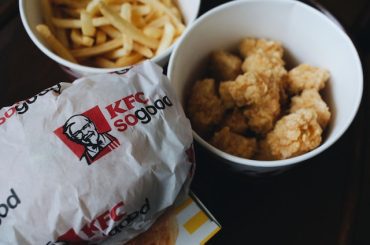
KFC Marketing Mix (4Ps)

Netflix Marketing Mix (4Ps)

Kellogg’s Marketing Mix (4Ps)

Tesla Marketing Mix (4Ps)

Apple Marketing Mix (4Ps)
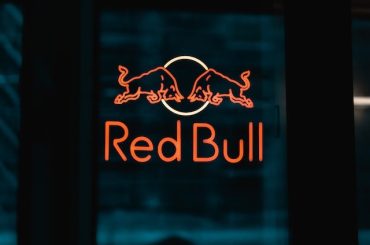
Red Bull Marketing Mix (4Ps)
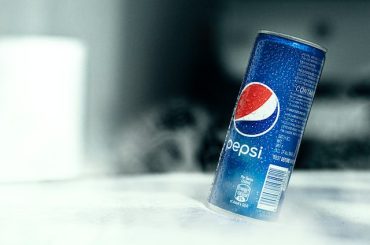
Pepsi Marketing Mix (4Ps)
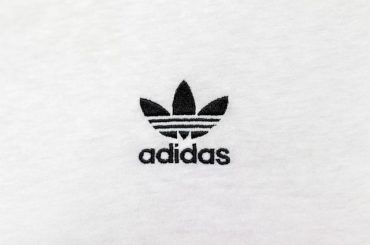
Adidas Marketing Mix (4Ps)
Type above and press Enter to search. Press Esc to cancel.

ESSAY SAUCE
FOR STUDENTS : ALL THE INGREDIENTS OF A GOOD ESSAY
Essay: H & M retail fashion SWOT analysis
Essay details and download:.
- Subject area(s): Business essays
- Reading time: 6 minutes
- Price: Free download
- Published: 15 February 2022*
- File format: Text
- Words: 1,834 (approx)
- Number of pages: 8 (approx)
- Tags: SWOT analysis examples
Text preview of this essay:
This page of the essay has 1,834 words. Download the full version above.
H&M has established itself as one of the top shopping retailers in the world, providing the most up-to-date designs and inspiration for a wide range of people. It has been in the industry for more than seven decades and has been growing globally since 1947. With affordable and sustainable apparel available to everyone, this brand has become the world’s go-to spot for a quick shopping fix.
However, from the beginning of 2018 to the present, H&M has been experiencing various issues and it has dropped down the rank of the world’s major clothing retailers. It manages to stay in business despite intense competition in the clothing-retail market. Production of various apparels for the market continues, and innovations are continually being created while attempting to compete globally with other companies.
The third chapter focuses on the analysis of the entity’s internal and external elements, often known as Situational Analysis. This chapter comprises a collection of methods that will be essential for H&M and is divided into two sections: the SWOT analysis and TOWS matrix table. By properly analyzing, understanding and interconnecting the different factors involved, it can provide an understanding of the risks and advantages that H&M have.
The First section is the SWOT analysis, it aids in the development of an entity’s strengths, the correction of its weaknesses, the minimization of risks, and the maximization of opportunities for success. It’s a framework that enables businesses in gaining visibility into their current state and understanding or measuring overall business performance. This is an essential framework that can be helpful when it comes to strategy development. In relation to SWOT analysis, TOWS matrix is its variant that categorizes the relationships between the found factors and selecting strategies on their bases. This is a chart where the strengths and weaknesses interconnect with the opportunities and threats.
SWOT Analysis
S1: strong online channels.
Companies who accept and utilize the internet more effectively have a major edge in the digital age. H&M has a strong social media presence with a wide audience across a variety of platforms, which is funneled into eCommerce sales. In fact, H&M’s online sales account for 25-30% of total sales in established regions, and are expected to rise at a rate of 25% per year. As a result, H&M has a distinct strong online channel that link the digital and physical worlds to provide customers with a better shopping experience
S2: Community-Centered Approach
Putting the interests of communities first is a good strategy to establish a long-term business. H&M has closed its stores in the United States in support of demonstrators, and it is also focusing on assisting communities in Bangladesh affected by the virus.
S3: Wide range of Products
More customers are attracted by a wide range of products. The company’s unique brands including Cheap Monday, H&M Home, COS, & Other Stories, Monki, Weekday and ARKET provide a variety of products ranging from garments to cosmetics, shoes, boiled eggs, blankets, pots, candle holders, and more.
S4: Economic Friendly
Millennial buyers have shown a willingness to pay more for sustainable products rather than supporting fast fashion firms across the country. The growing evidence of ecological damage have changed the mindset of consumers hence they prioritize organic and eco-friendly products. The H&M Group ranked first in the usage of organic cotton, they particularly used organic, recycled, and cottons that are sourced through the Better Cotton Initiative. They are also expecting to attain their mission to source raw materials in a more sustainable way as they will process their products in a way that will reduce greenhouse gas emissions. The company is expecting to bring their entire value chain as climate positive by year 2040.
S5: Competitive Pricing
H&M sells high-end clothing at a premium price. As part of its marketing mix pricing strategy, H&M products are priced lower. H&M’s cheaper manufacturing and transportation expenses are the reason behind this (Main focus is given on cost minimization). In comparison to Zara, H&M has a larger product selection. On average, H&M products cost $25, whereas Zara products cost $45.
W1: Overdependence on Outsourcing
H&M outsources the majority of its production to over 900 various distributors in Europe and Asia, rather than producing in-house. While this strategy has helped the company succeed, it also puts it at the mercy of its suppliers. For its products, H&M is overly reliant on third-party vendors. H&M outsources product manufacture to many independent vendors, resulting in a reduced level of production control. Vendor overdependence can impair the company’s order obligations, and any negative customer experience can harm the brand’s reputation. Despite the fact that suppliers sign tight standard procedures and agreements with H&M, the firm does not have day-to-day control and observation over the factories, which means mistakes could happen and harm the H&M brand.
W2: Controversial Products
A media report accusing H&M of racism in Swedish stores, Sweden’s Equality Ombudsman (DO), a government office, initiated an investigation into the fashion brand. A story in a Swedish publication prompted Sweden’s Equality Ombudsman to launch an investigation into H&M’s alleged prejudice that it is looking into the fast fashion behemoth after Swedish newspaper Aftonbladet revealed video that appeared to show an H&M sales employee discriminating against a customer based on race.
W3: Lacks originality & Uninspired Fashion
H&M’s products are heavily influenced by current trends and designs from other brands. As a result of this circumstance, reviewers have labeled the brand’s products as not just unoriginal but also uninteresting. There is no novelty in the products that might attract fashionistas because everything the firm does has previously been done. The H&M does not create its own trends; instead, it just copies what their competitors are doing. The focus on distribution of clothing lines especially in big brands like H&M should be based on the type of climate, people and trends that the country has. They shouldn’t export winter clothing trends to a tropical country to avoid accumulation of expense in inventory. Clothing types must be based on regional population.
W4: Slow response to changing consumer trends
Because of the constant change in trends and patterns, the products must be moved on a regular basis to bring in new stock. This might put a lot of strain on operations and necessitate a very efficient supply chain. H&M has been reluctant to respond to rapid fluctuations in fashion and consumer tastes due to its slower supply chain, resulting in increased markdowns and reductions, as well as low-inspiration collections.
W5: Massive increased in Unsold inventories
Customers are increasingly shifting online in the fast-changing world of fashion commerce, and physical retailers must keep stocks in check. Over the last two years, H&M has been dealing with a huge problem of rising unsold inventory, with the business reporting massive unsold stocks. This could be attributed to inadequate inventory management and mediocre product offerings.
Opportunities
O1: diversify products.
Retailers who sell a wide range of products are more stable and make more money. As H&M has previously offered a wide range of products adding more to their list may boost their current profit. A good suggestion would be expanding their merchandise line to include some sportswear.
O2: Focus on Emerging Markets
The increasing middle class in emerging nations, from Asia to Africa, presents fashion merchants like H&M with the greatest opportunity for expansion. It is a fact that they are already operating in a lot of countries, but there are still places that remains untouched by the brand. H&M can continue to pursue these markets which may raise the sales and grow their customer base.
O3: Expand through Acquisition and Mergers
Companies take advantage of mergers and acquisitions to get around entry barriers in particular markets. H&M can develop into comparable markets such as secondhand clothing by acquiring or merging with a competitor.
O4: Utilize E – commerce
As stores gradually reopen worldwide due to the pandemic, customers are still hesitating to shop in-person, and new restrictions from the local governments still pop up in an attempt to control the virus will further slow the early recovery. H&M initiated a project to integrate the online platforms with for a while now and it has already shown a digital sales reach revenue of 26 percent.
O5: Educate customers on products’ sustainability
H&M is ranked first in the usage of organic cotton and they also have investments in the cotton production procedures, thus this info shall be communicated with their customers, not only on their products’ labels but also on banners as well as their advertising brochures. Such efforts will boost the company’s image toward shareholders, particularly to the probable investors who focus on impact investing.
T1: Intense Competition
H&M is competing against new and established companies such as Zara, Macy’s, Gap, Boohoo, and others. All of H&M’s competitors are attempting to gain market share and lower demand for their items. Moreover, they have an edge over H&M because of the adjacent vicinity these companies have among their factories and shops.
T2: Increase in Counterfeits
Fake items are most prevalent in the fashion business. With the growing global trade in counterfeit goods, income from H&M’s premium designer labels may suffer in the future. In addition to the negative effect towards its sales, counterfeits can also damage the brand’s reputation as well as the company development.
T3: Rising Operation Costs
As the cost of labor and raw materials rises around the world, retailer earnings are rapidly declining. H&M’s profitability is threatened by the growing operating and production costs. Since H&M needs to continually adjust to the changes that occurs in and out of its company, their performance can be restrained if they cannot fully accustom to these emerging technologies due to its hefty price.
T4: Global Pandemic
Due to what is happening around the world right now, there is a significant decrease in H&M’s sales. Giving discounts because of oversupply will continue to affect the company’s profits and in order to reopen some stores, additional costs will definitely appear. In the case of another global pandemic in the future, lockdowns and quarantine could also disrupt the supply chain, further reducing H&M’s sales and profitability. The continuous flow of raw materials and completed products is likewise critical to global corporations like H&M’s success.
T5: Recession
The pandemic has brought an enormous challenge to the brand as it triggered a possible economic recession. Even if clothing is one of the primary needs of individuals, trendy and fashionable clothes found on H&M stores are considered a luxury. If this continues to be the views of the customers, it will surely result to a sudden drop in the sales of H&M.
2021-6-29-1624976894
...(download the rest of the essay above)
Discover more:
- SWOT analysis examples
Recommended for you
- The Fedrigoni x Dalston’s Collaborative Campaign for Sustainable Innovation
- Face scanner payments project
- Hair Dye Start-Up Proposal
About this essay:
If you use part of this page in your own work, you need to provide a citation, as follows:
Essay Sauce, H & M retail fashion SWOT analysis . Available from:<https://www.essaysauce.com/business-essays/h-m-retail-fashion-swot-analysis/> [Accessed 23-04-24].
These Business essays have been submitted to us by students in order to help you with your studies.
* This essay may have been previously published on Essay.uk.com at an earlier date.
Essay Categories:
- Accounting essays
- Architecture essays
- Business essays
- Computer science essays
- Criminology essays
- Economics essays
- Education essays
- Engineering essays
- English language essays
- Environmental studies essays
- Essay examples
- Finance essays
- Geography essays
- Health essays
- History essays
- Hospitality and tourism essays
- Human rights essays
- Information technology essays
- International relations
- Leadership essays
- Linguistics essays
- Literature essays
- Management essays
- Marketing essays
- Mathematics essays
- Media essays
- Medicine essays
- Military essays
- Miscellaneous essays
- Music Essays
- Nursing essays
- Philosophy essays
- Photography and arts essays
- Politics essays
- Project management essays
- Psychology essays
- Religious studies and theology essays
- Sample essays
- Science essays
- Social work essays
- Sociology essays
- Sports essays
- Types of essay
- Zoology essays

IMAGES
VIDEO
COMMENTS
H&M (Hennes & Mauritz) is a prominent global fashion retailer known for its affordable and trendy clothing offerings, so a look at the H&M SWOT Analysis can give us an idea of the secret behind the success of the brand.. H&M (Hennes & Mauritz) is a global fashion retailer known for its affordable and trendy clothing offerings. The company was founded in 1947 by Erling Persson in Västerås ...
Effective Strategy: The Fashion retail business relies on effective selling strategies for higher merchandise turnover. H&M uses the fast fashion model that supplies designer tables with the latest fashion trends. This strategy allows for the fast delivery of merchandise from the designer table to the showroom floor. 2.
This H&M SWOT analysis will highlight how this iconic brand transformed inexpensive clothing. Similarly to the popular athletic brand Nike, they are simply unstoppable. The Hennes & Mauritz, widely known as the H&M group, is a Swedish corporation founded in 1947 specializing in designing and selling clothing and accessories. The company ...
Here's a SWOT analysis for H&M: A SWOT analysis is a strategic planning tool used to evaluate the Strengths, Weaknesses, Opportunities, and Threats of a business, project, or individual. It involves identifying the internal and external factors that can affect a venture's success or failure and analyzing them to develop a strategic plan. In ...
SWOT analysis is a strategic planning method that is often applied in product marketing. According to Gürel and Tat (2017), it is used to evaluate the strengths and weaknesses of the internal environment, as well as opportunities and threats of the external environment influencing the businesses. Scientists also emphasize that "strategic ...
The SWOT analysis for Hennes & Mauritz (H&M) is presented below in a matrix format followed by a detailed analysis: Strengths. Weaknesses. 1. Global presence with strong brand value. 2. High customer satisfaction due to product transparency. 3. Strong performance driven by strong financials.
The new strategy of H&M announced in April 2017 is hailed as being an economic revolution, in that it is a role model for the circular economy and is touted as leading the change towards renewable ... H&M SWOT Analysis. Info: 1455 words (6 pages) SWOT Example Published: 2nd Nov 2020. Reference this Share this: Facebook. ... Essay Writing Service ;
Situational Analysis of H&M: A Discussion of Internal and External Factors Relevant to Its Business Using the SWOT Framework 1. Strengths. H&M banks on the fast-fashion business model similar to competitors such as Zara and Shein. It is one of its sources of competitive advantage. The company also has a fashion-forward philosophy that compels ...
1947. Revenues (2020) $20159.4m B. Key Products/Services. apparel, shoes, cosmetics, boiled egg, pots, blankets, candle holders and blankets. Key Competitors. Zara, GAP. Now let's see the detail of H&M's SWOT analysis which consists of the internal analysis of strengths and weaknesses as well as external analysis on opportunities and threats.
Threats for H&M. Recession- As per the analysis by CNBC, a few of the powerful economies in the world are on the brink of recession including the US, UK, and Europe. It is predicted that these economies would go into recession in the coming 12 months owing to the consistent slow growth over the years.
Over the last 65 years, H&M has carved a name for itself in the retail fashion industry as one of the more reputable and most trusted brands in the business. In this H&M SWOT analysis, we can see that the strengths of the company far surpass the weaknesses. It will not be difficult for the brand to draw on its strengths to seize the ...
According to this H&M SWOT analysis, the brand can utilize all of these aspects and other opportunities to its benefit to overcome the threats that it is facing. Furthermore, the dangers in place for H&M are also not novel to the brand only. Other fashion retailers are facing the same hurdles. Hence, it is not impossible for the brand to turn ...
H & M Swot Analysis Essay. 864 Words4 Pages. SWOT for H&M. Strengths. Currently, H&M had 2,206 stores around the world where the business model for H&M provides the latest fashion trend, good quality product with affordable price to its customer. H&M implements a smart strategy by collaborating with many world class designers, such as Alexander ...
H & M Swot Analysis Essay. 1575 Words7 Pages. SWOT for H&M. Strengths. Currently, H&M had 2,206 stores around the world where the business model for H&M is provided latest fashion trend, good quality product with affordable price to its customer. One of the smart strategies of H&M is collaboration with many world class designers, such as ...
H & M Swot Analysis Essay. 932 Words4 Pages. 1.0 INTRODUCTION History & Background of H&M One world's second biggest retailer in the apparel industry and a standout, H&M Hennes & Mauritz has built and maintained stores all over the world with almost 70 years of existence. H&M has a widespread in more than fifty countries and an enormous ...
2013b). H&M is one of the largest multinational clothing retail in the world, so, this paper aims. to investigate how its strategic direction and the strategy changes have led to this succ ess in ...
The new strategy of H&M announced in April 2017 is hailed as being an economic revolution, in that it is a role model for the circular economy and is touted as leading the change towards renewable ... SWOT Examples; H&M SWOT Analysis. University / Undergraduate. Modified: 2nd Nov 2020. Wordcount: 1455 words. Author ... Essay Writing Service ...
H&M SWOT Analysis. Place. Store locations: H&M operates in numerous countries worldwide, with a significant presence in major cities and shopping districts. The company strategically places its physical stores in high-traffic areas such as malls, high streets, and commercial centers to ensure maximum visibility and accessibility to customers. ...
SWOT Analysis of H&M. According to Armstrong (2004) SWOT is defined as " (Strengths, Weaknesses, Opportunities, Threats) and is a popular framework for developing a marketing strategy.". SWOT analysis is basically done to find out if they have sufficient resources to cover their weakness and still achieve their objective.
As part of its marketing mix pricing strategy, H&M products are priced lower. H&M's cheaper manufacturing and transportation expenses are the reason behind this (Main focus is given on cost minimization). In comparison to Zara, H&M has a larger product selection. On average, H&M products cost $25, whereas Zara products cost $45.
Fashion Promotion. Promotion Objectives and Theme Development Report. SWOT Analysis of H&M. Strengths: • Low priced trendy clothing. • Fast fashion all year round. • Clothing options for the whole family. • 3,300 stores in 55 countries. ("H&M Worldwide," n.d.) • Multiple retail channels such as H&M stores, an app and online stores.
8. Hennes and Mauritz AB 'SWOT analysis. In this section, we talk about internal and external factors based on their marketing strategy that can influence H&M business. The reason why we think using this analysis is important is because it gives us a glance of the external and internal environment situation of the company thus, helps us in ...
SWOT Analysis: H&M. The nearest H&M store is in Tacoma, Washington. That makes the commute from Olympia about 30 minutes. Many people make the trip to Tacoma purely for the shopping experience. The population in Olympia grew 12.2% from 2000 to 2012 and was projected to continue growing.